Sometimes Dreams are Wiser than Waking
March 30 - May 5, 2019 | Third Floor
Plains Ledger Drawings 1865 - 1910
-

Installation view, Sometimes Dreams are Wiser than Waking: Plains Ledger Drawings 1865-1910, Third Floor, 2019
-

Installation view, Sometimes Dreams are Wiser than Waking: Plains Ledger Drawings 1865-1910, Third Floor, 2019
-

Installation view, Sometimes Dreams are Wiser than Waking: Plains Ledger Drawings 1865-1910, Third Floor, 2019
-

Installation view, Sometimes Dreams are Wiser than Waking: Plains Ledger Drawings 1865-1910, Third Floor, 2019
-

Installation view, Sometimes Dreams are Wiser than Waking: Plains Ledger Drawings 1865-1910, Third Floor, 2019
-
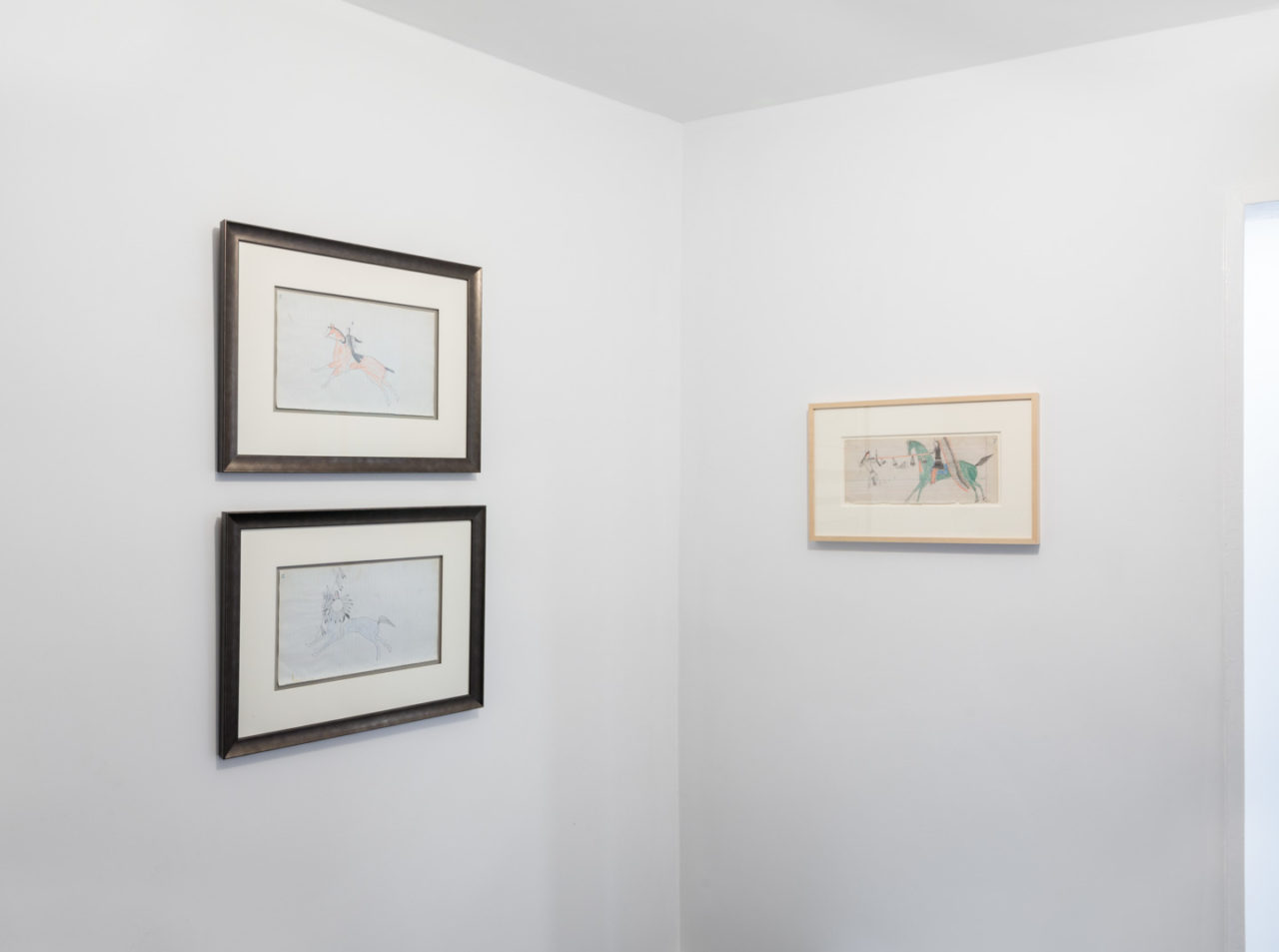
Installation view, Sometimes Dreams are Wiser than Waking: Plains Ledger Drawings 1865-1910, Third Floor, 2019
-
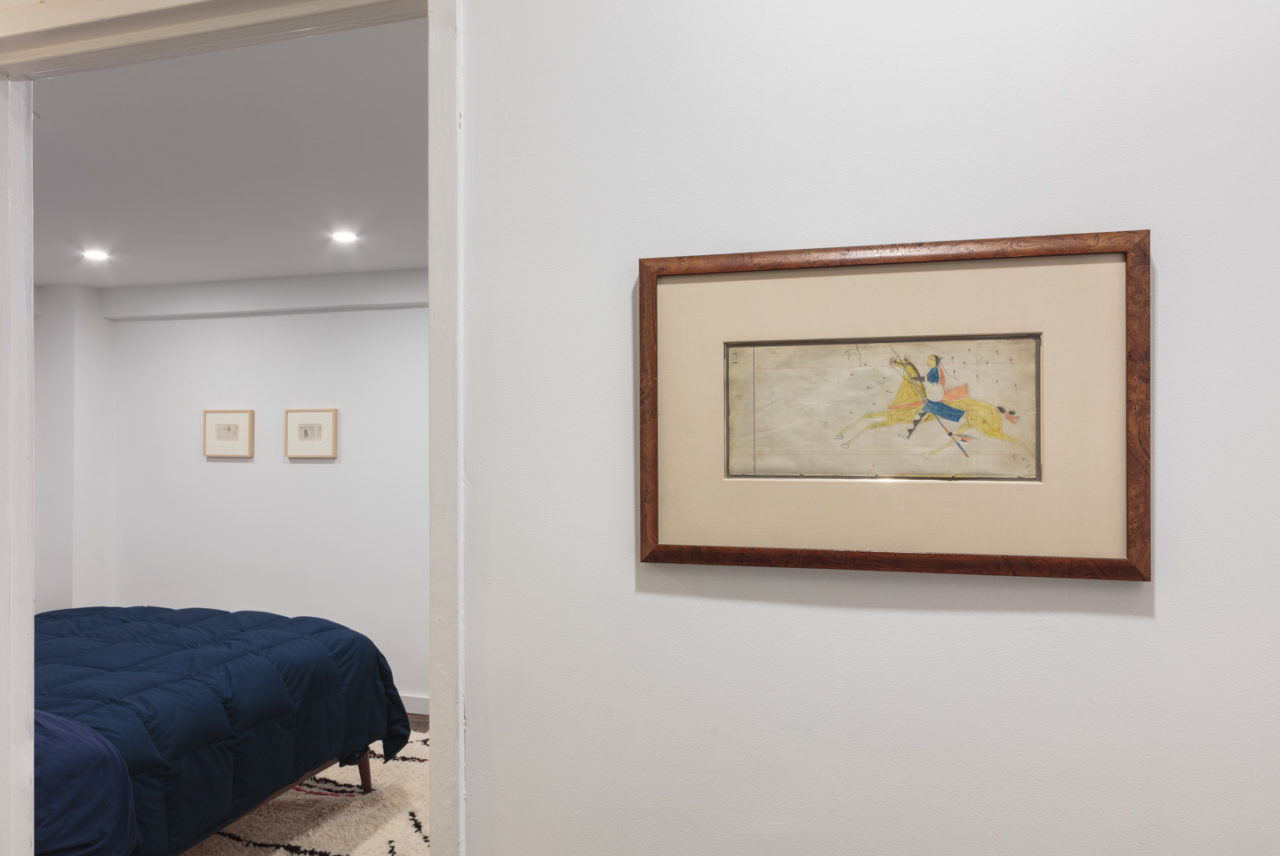
Installation view, Sometimes Dreams are Wiser than Waking: Plains Ledger Drawings 1865-1910, Third Floor, 2019
-
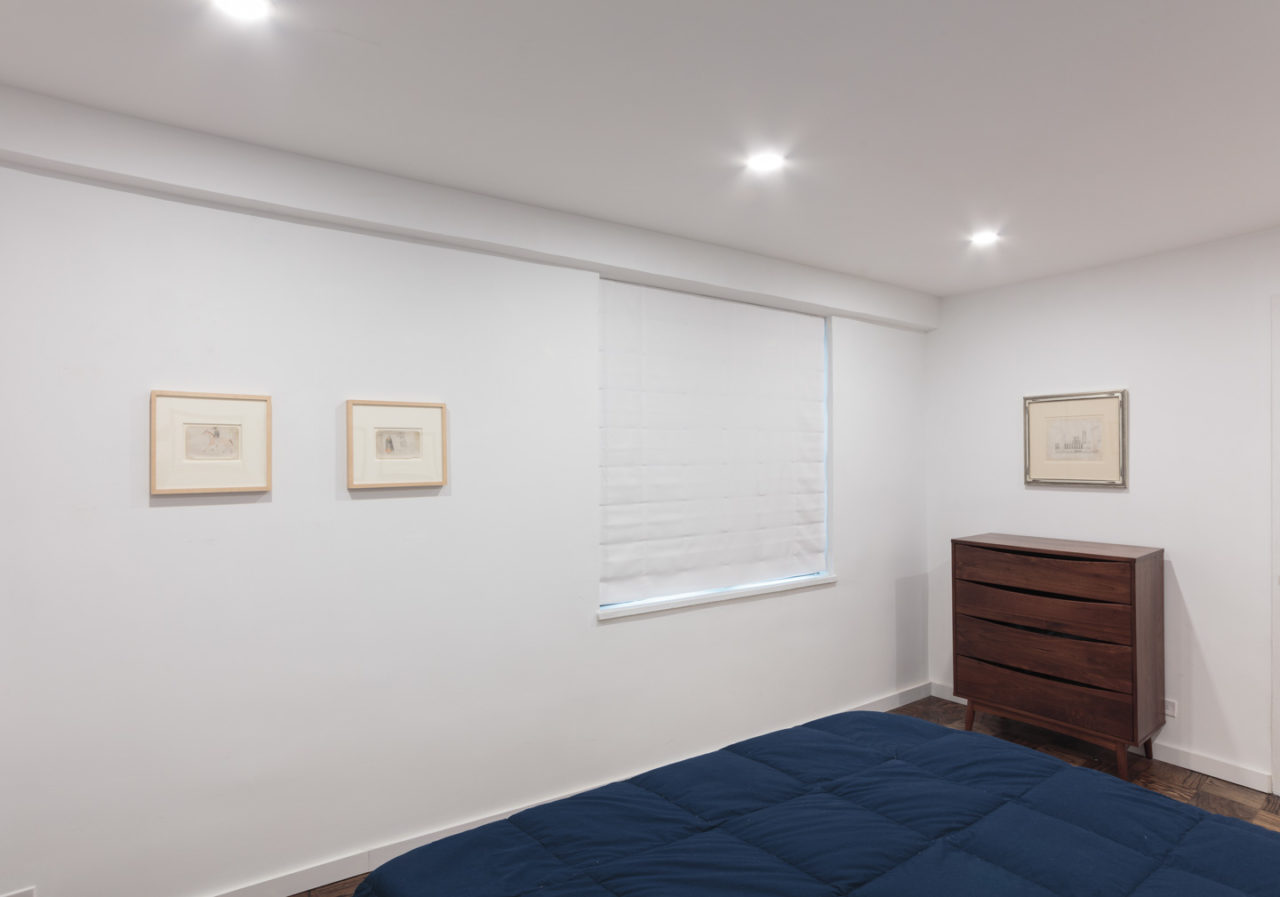
Installation view, Sometimes Dreams are Wiser than Waking: Plains Ledger Drawings 1865-1910, Third Floor, 2019
-

Installation view, Sometimes Dreams are Wiser than Waking: Plains Ledger Drawings 1865-1910, Third Floor, 2019
-
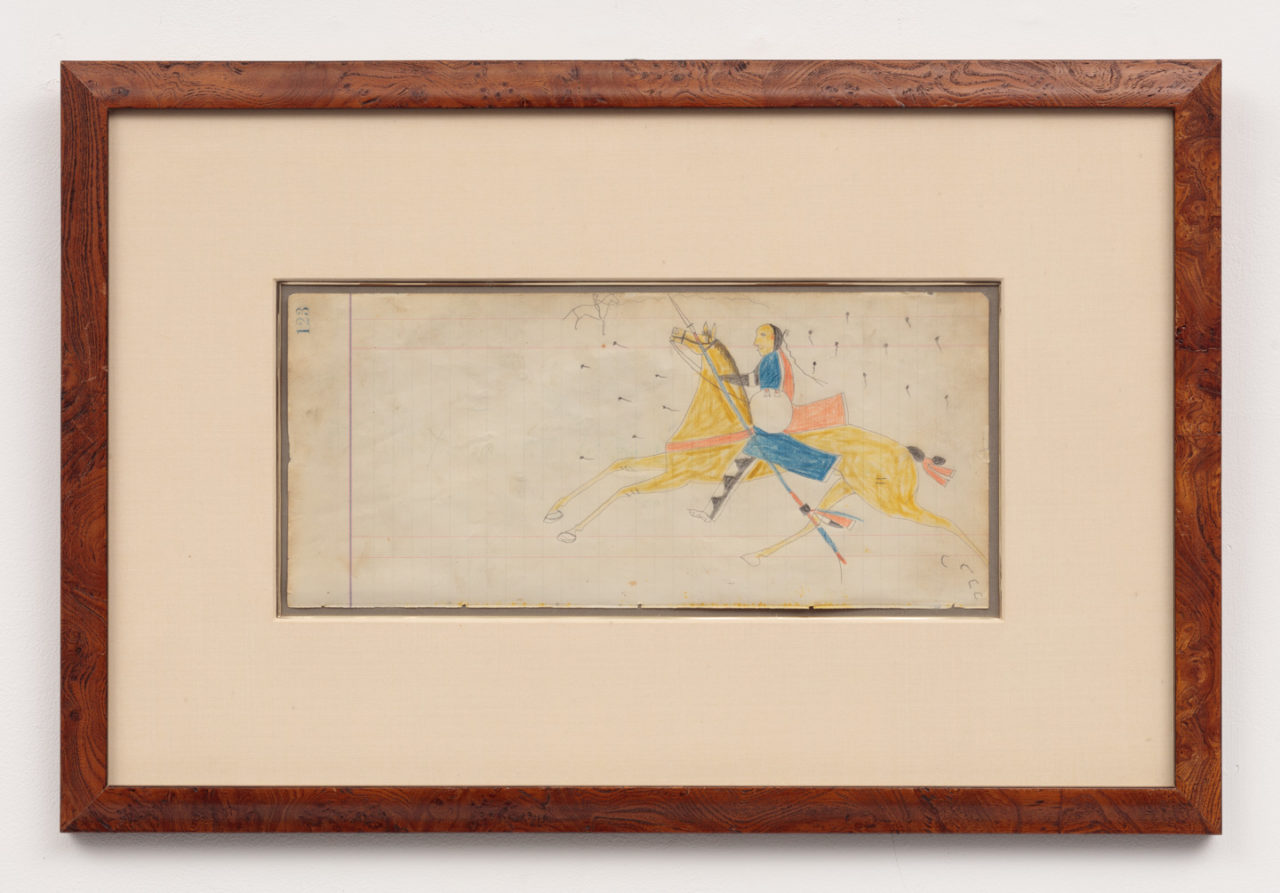
Frank Henderson (Hinono'eiteen/Arapaho, 1862-1885)
Horseback Escapes (Side A)
Henderson Ledger Book, p.123, c. late 19th century
Graphite and colored pencil on paper
5 1/3 x 11 3/4 inches -
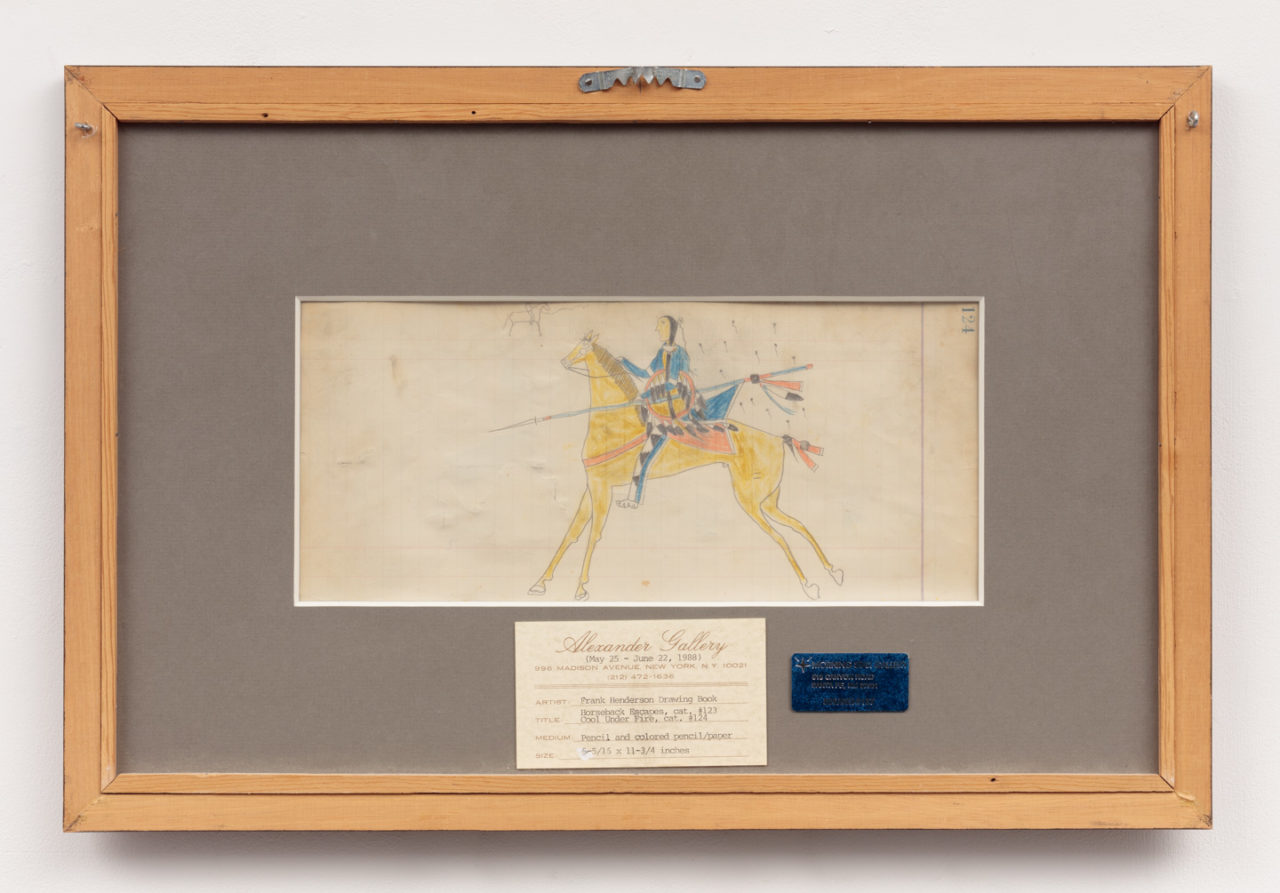
Frank Henderson (Hinono'eiteen/Arapaho, 1862-1885)
Cool Under Fire (Side B)
Henderson Ledger Book, p.123, c. late 19th century
Graphite and colored pencil on paper
5 1/3 x 11 3/4 inches -
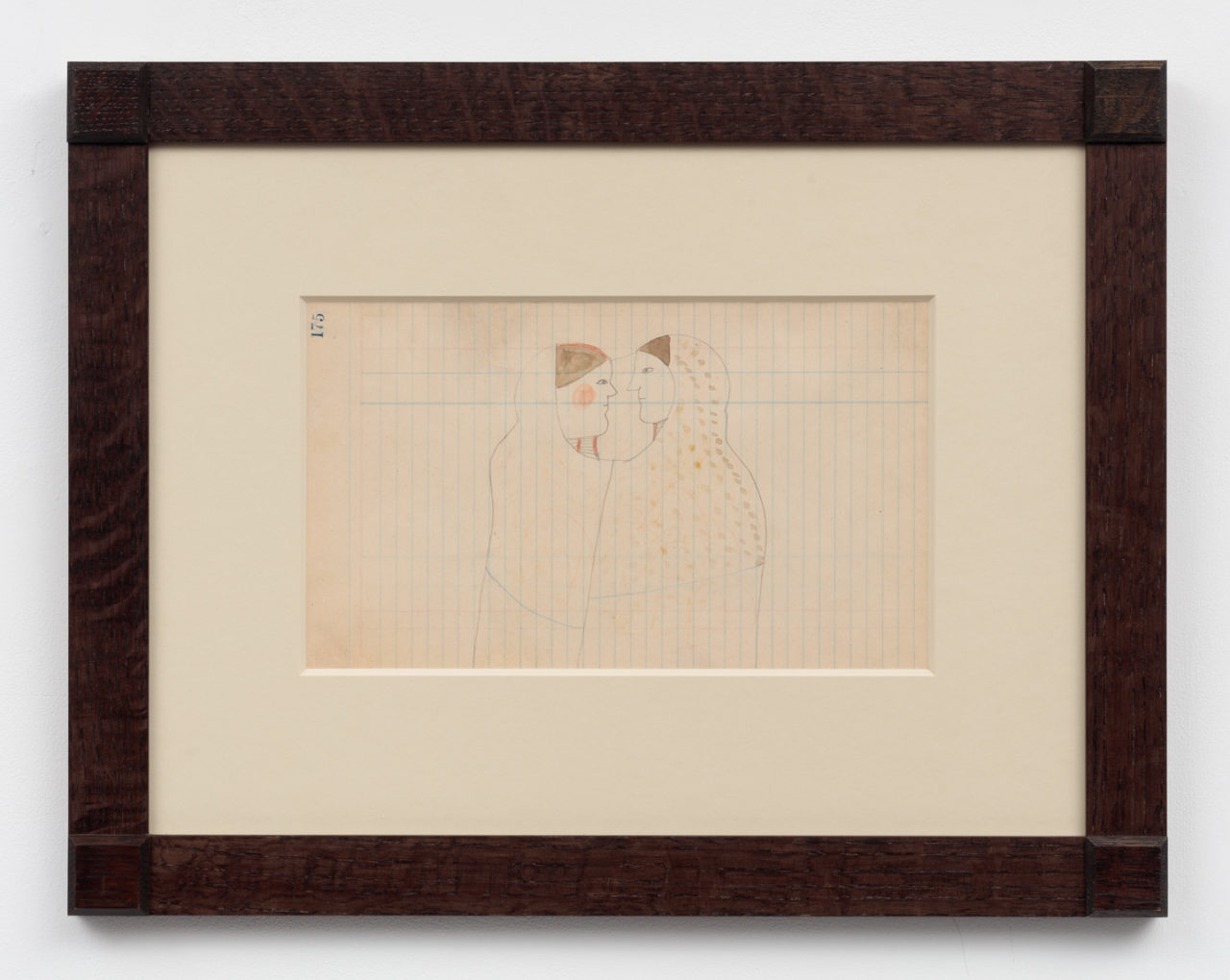
Unknown Cheyenne Artist
Courting Scene
Old White Woman Ledger Book, p.175, c. 1880-90
Graphite, colored pencil and watercolor on paper
7 5/16 x 11 13/16 inches
-
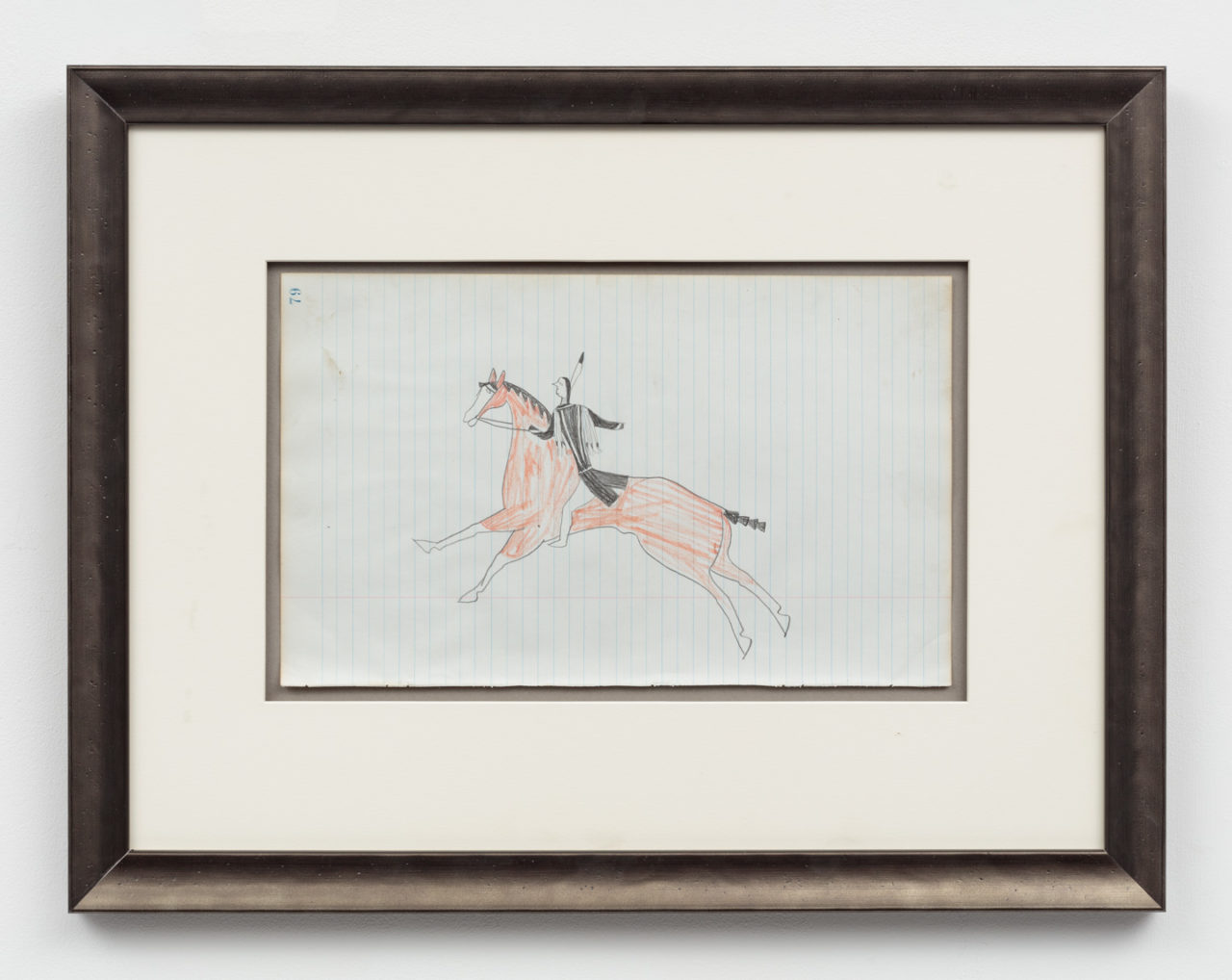
Ćehu´pa/Jaw, or Okicize Tawa, (Hunkpapa Lakota, b.1850)
Mounted Warrior with an Ermine Shirt on a Red Horse
Amidon Ledger Book, p.79, c. 1880
Graphite and colored pencil on paper
8 1/4 x 13 1/2 inches -
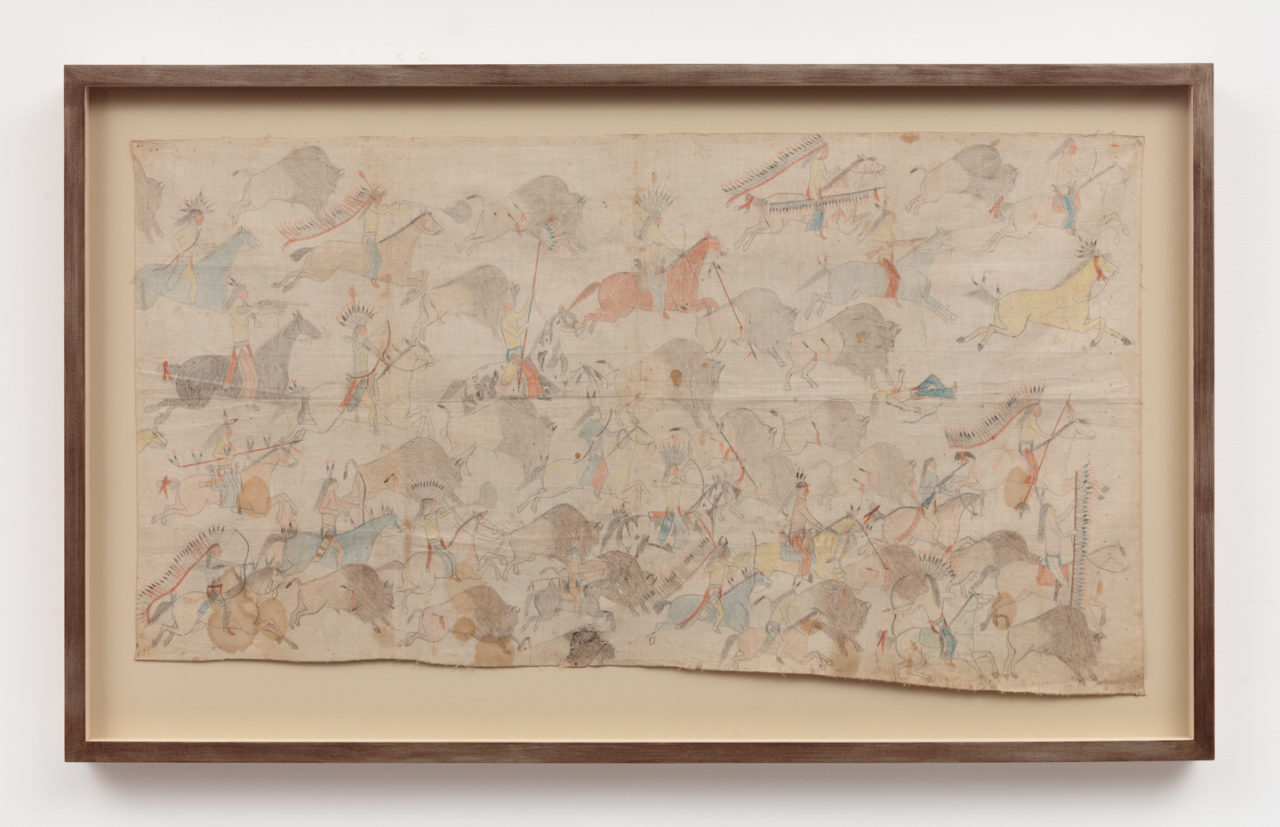
Unknown Sioux Artist
Buffalo Hunting Scene, c. 1910
Pigment on tipi muslin liner fragment
19 x 36 inches -
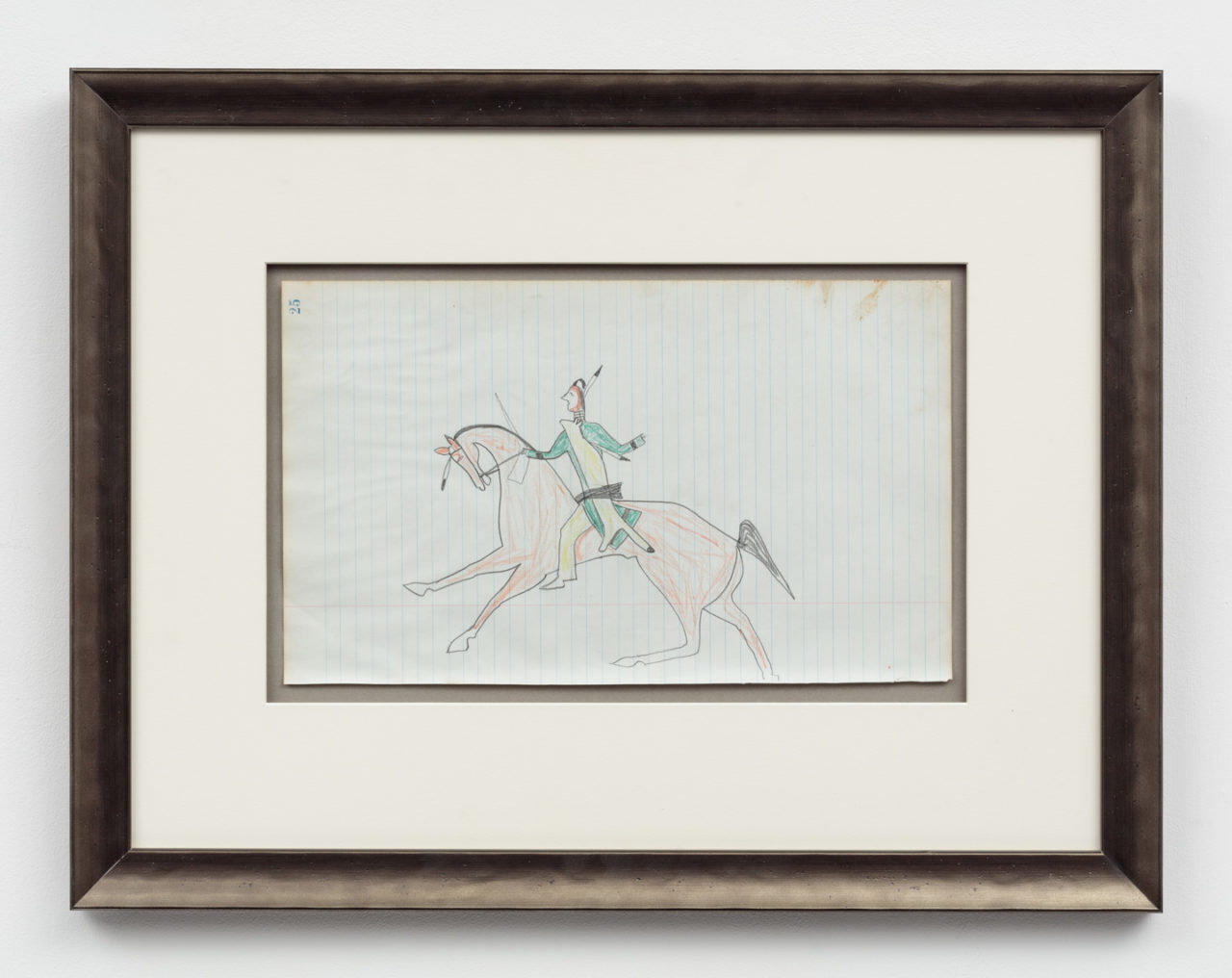
Ćehu´pa/Jaw, or Okicize Tawa, (Hunkpapa Lakota, b.1850)
Mounted Warrior with an Ermine Shirt on a Red Horse
Amidon Ledger Book, p.79, c. 1880
Graphite and colored pencil on paper
8 1/4 x 13 1/2 inches -
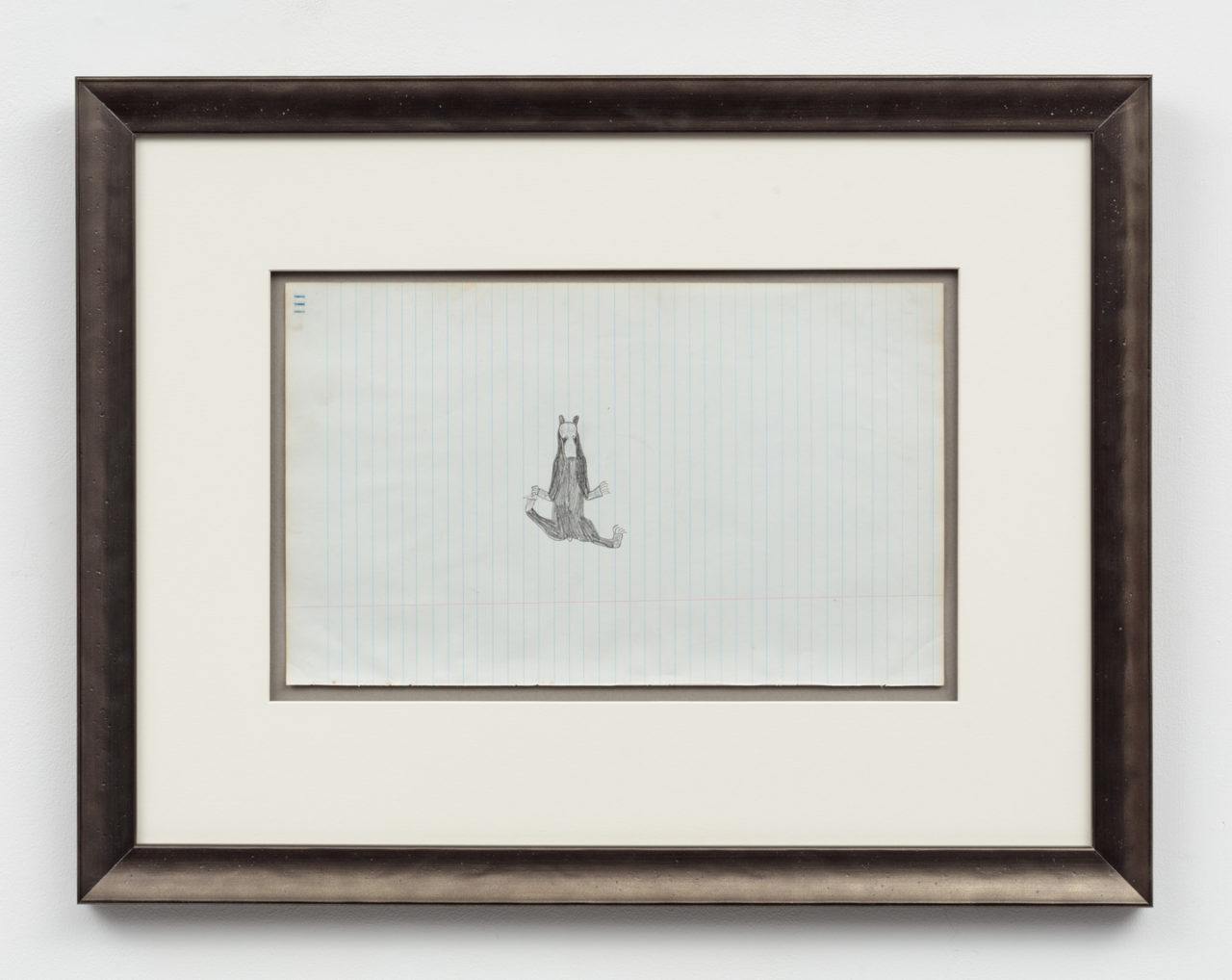
Ćehu´pa/Jaw, or Okicize Tawa, (Hunkpapa Lakota, b.1850)
Sitting Bear
Amidon Ledger Book, p.111, c. 1880
Graphite on paper
8 1/4 x 13 1/2 inches -
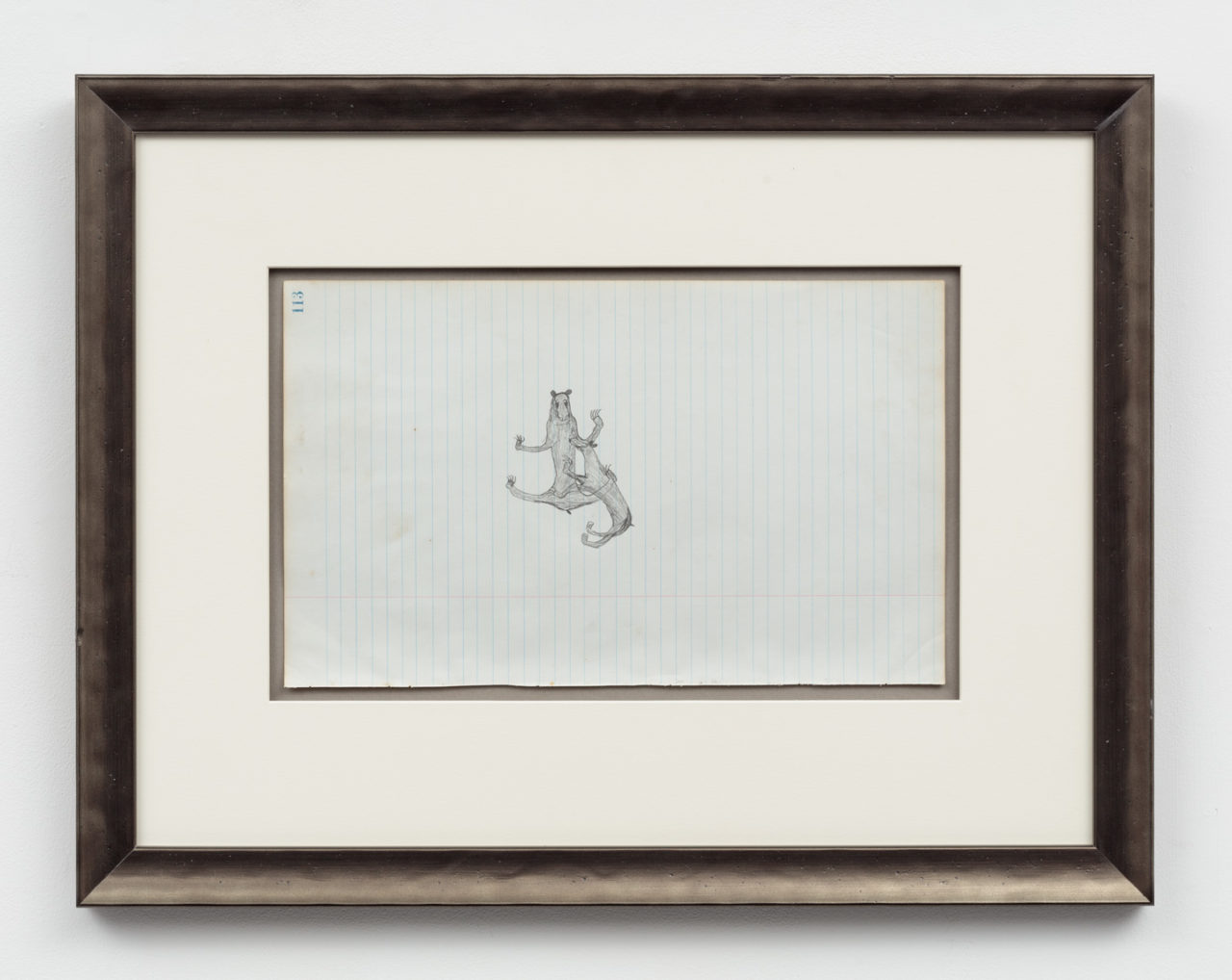
Ćehu´pa/Jaw, or Okicize Tawa, (Hunkpapa Lakota, b.1850)
Two Bears
Amidon Ledger Book, p.113, c. 1880
Graphite on paper
8 1/4 x 13 1/2 inches -
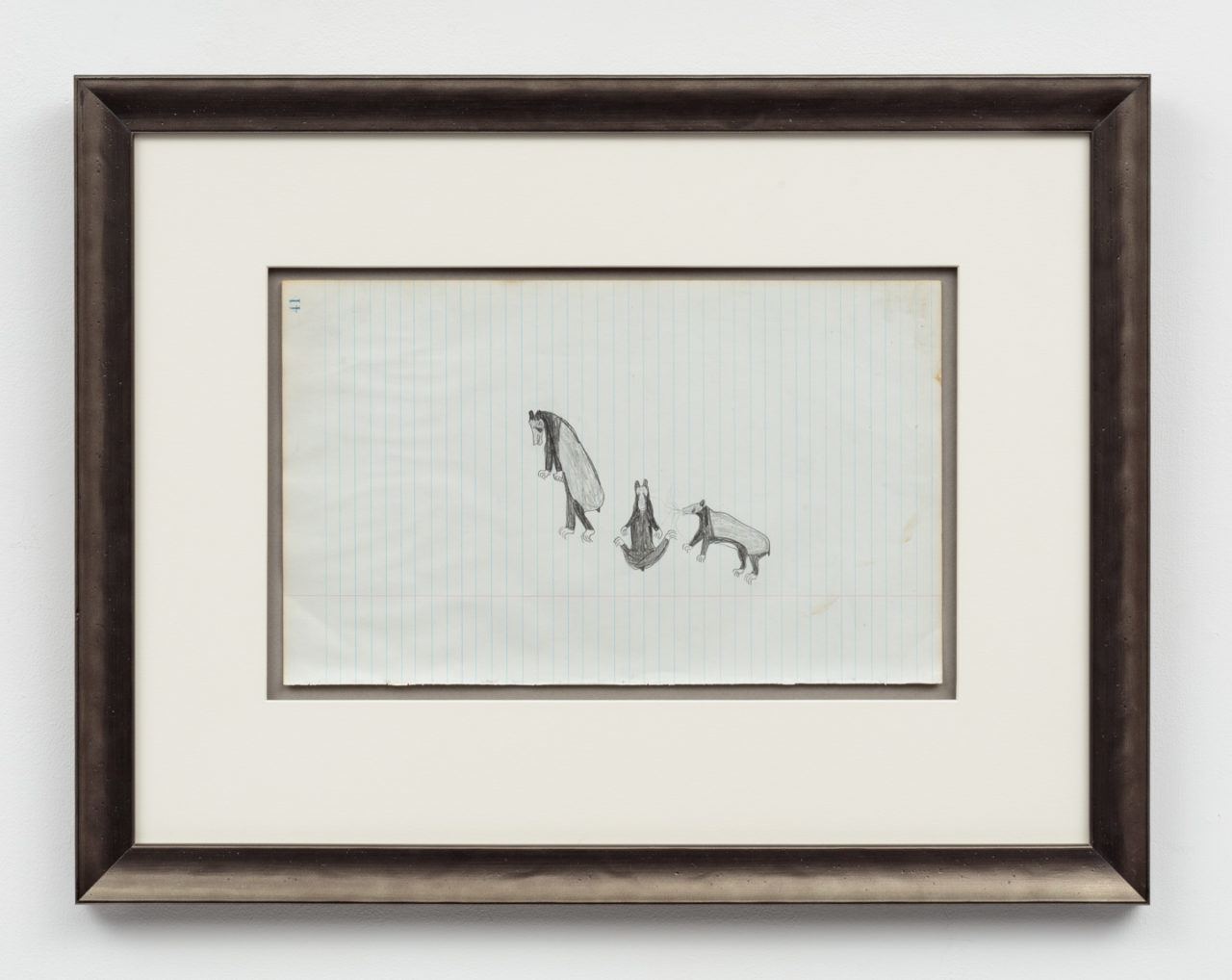
Ćehu´pa/Jaw, or Okicize Tawa, (Hunkpapa Lakota, b.1850)
Three Bears Amidon Ledger Book, p.41, c. 1880
Graphite on paper
8 1/4 x 13 1/2 inches -
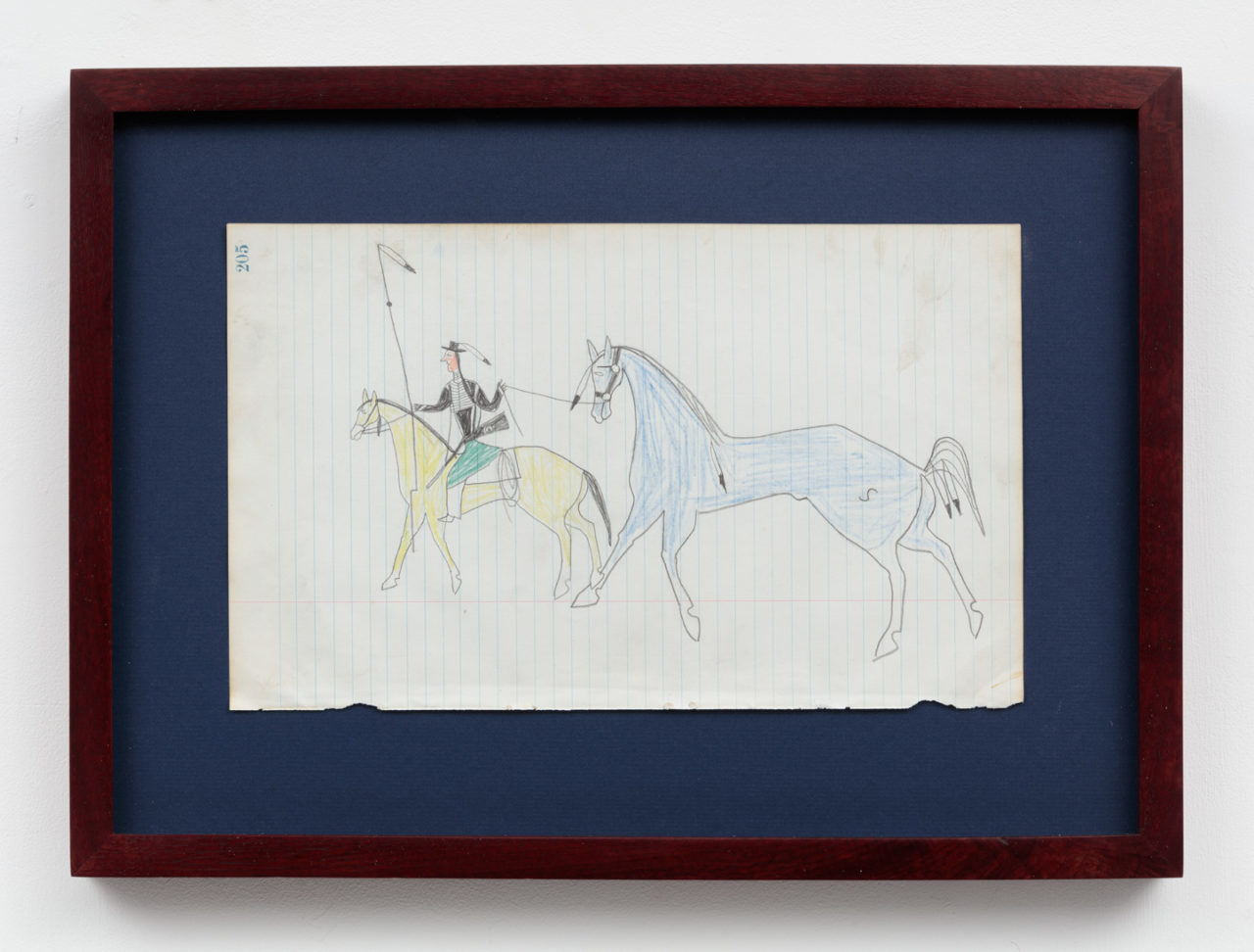
Ćehu´pa/Jaw, or Okicize Tawa, (Hunkpapa Lakota, b.1850)
Warrior Leading Charger
Amidon Ledger Book, p.205, c. 1880
Graphite and colored pencil on paper
8 1/4 x 13 1/2 inches -
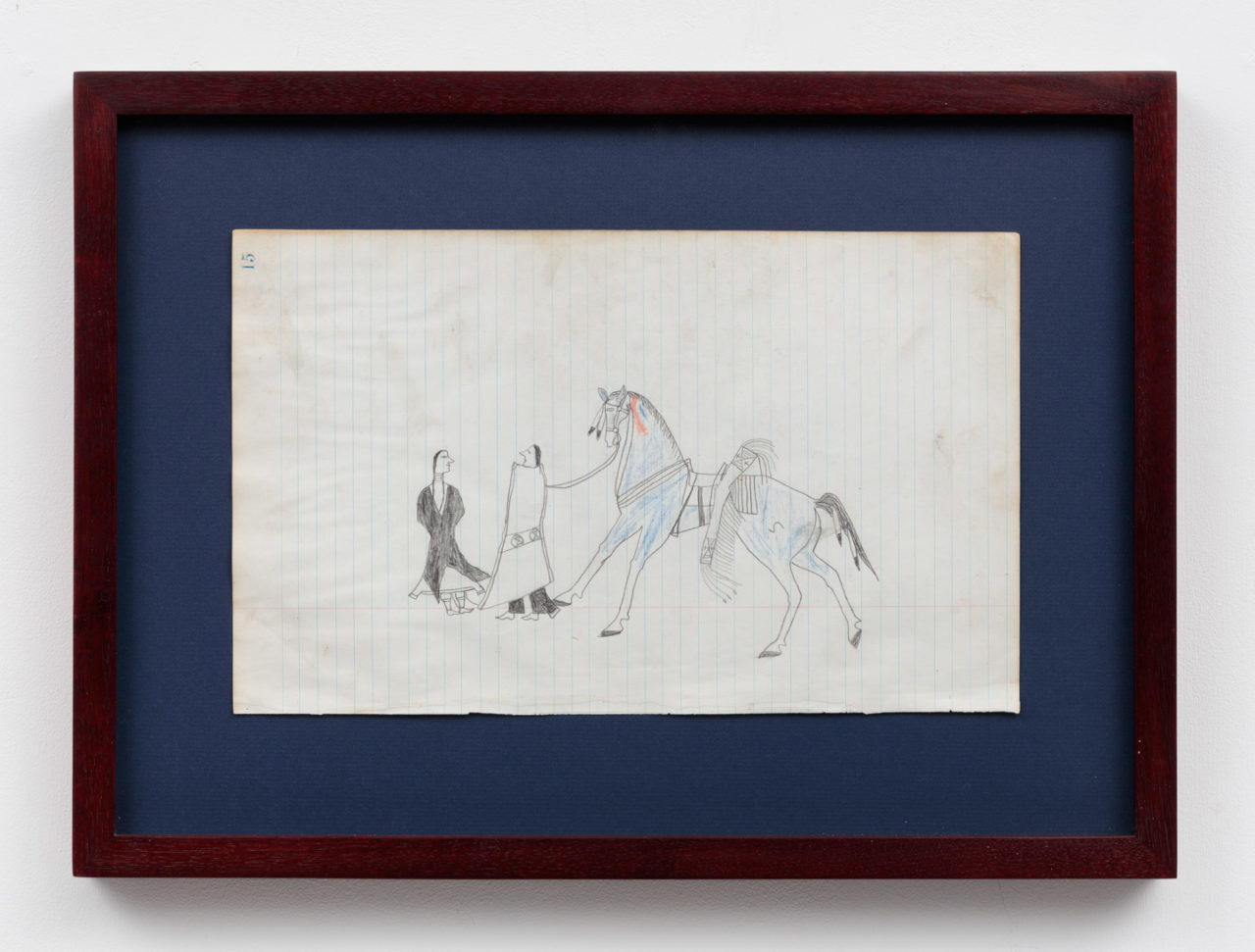
Ćehu´pa/Jaw, or Okicize Tawa, (Hunkpapa Lakota, b.1850)
Courting Scene
Amidon Ledger Book, p.15, c. 1880
Graphite and colored pencil on paper
8 1/4 x 13 1/2 inches -
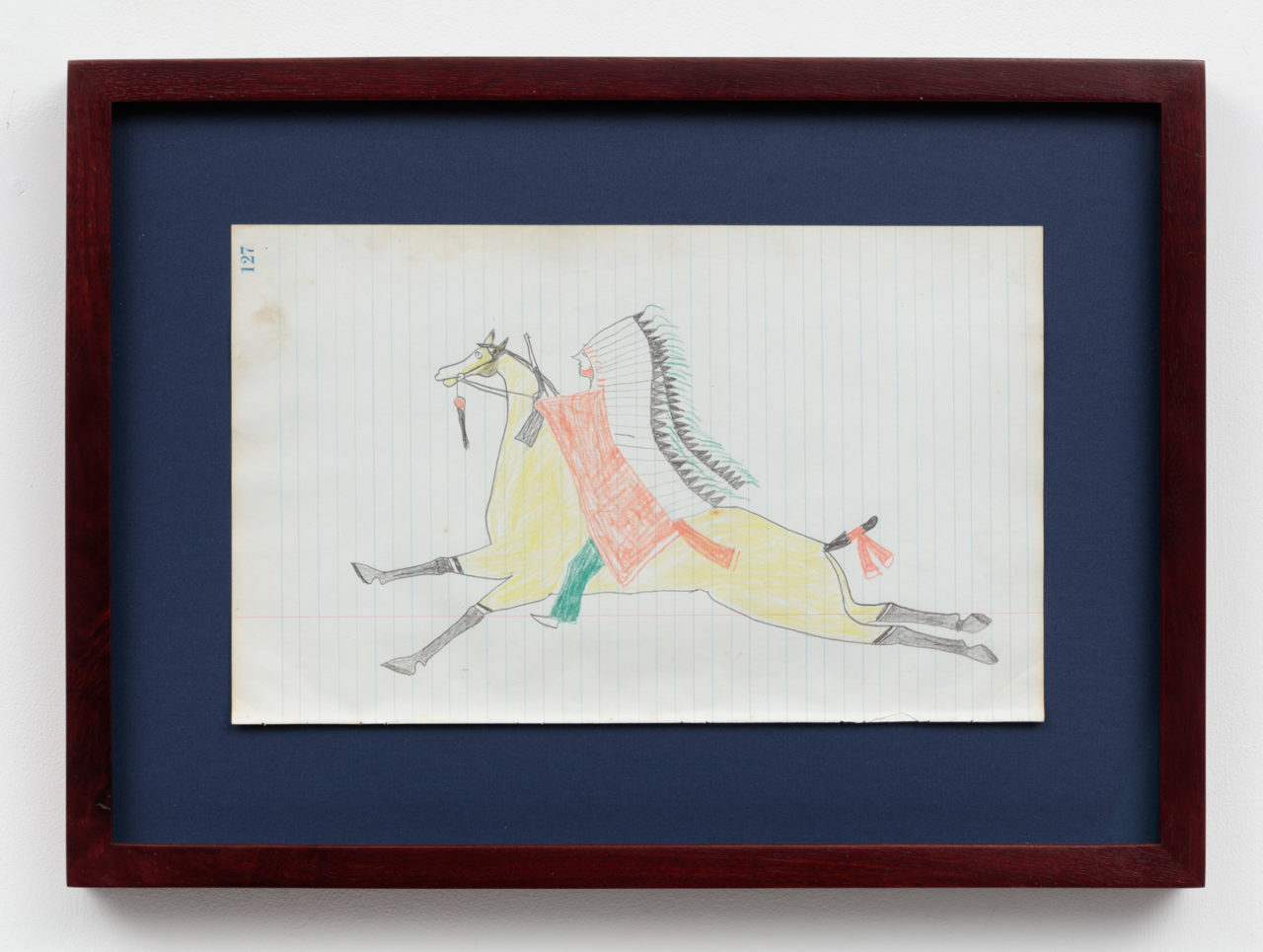
Ćehu´pa/Jaw, or Okicize Tawa, (Hunkpapa Lakota, b.1850)
Battle Scene
Amidon Ledger Book, p.127, c. 1880
Graphite and colored pencil on paper
8 1/4 x 13 1/2 inches -
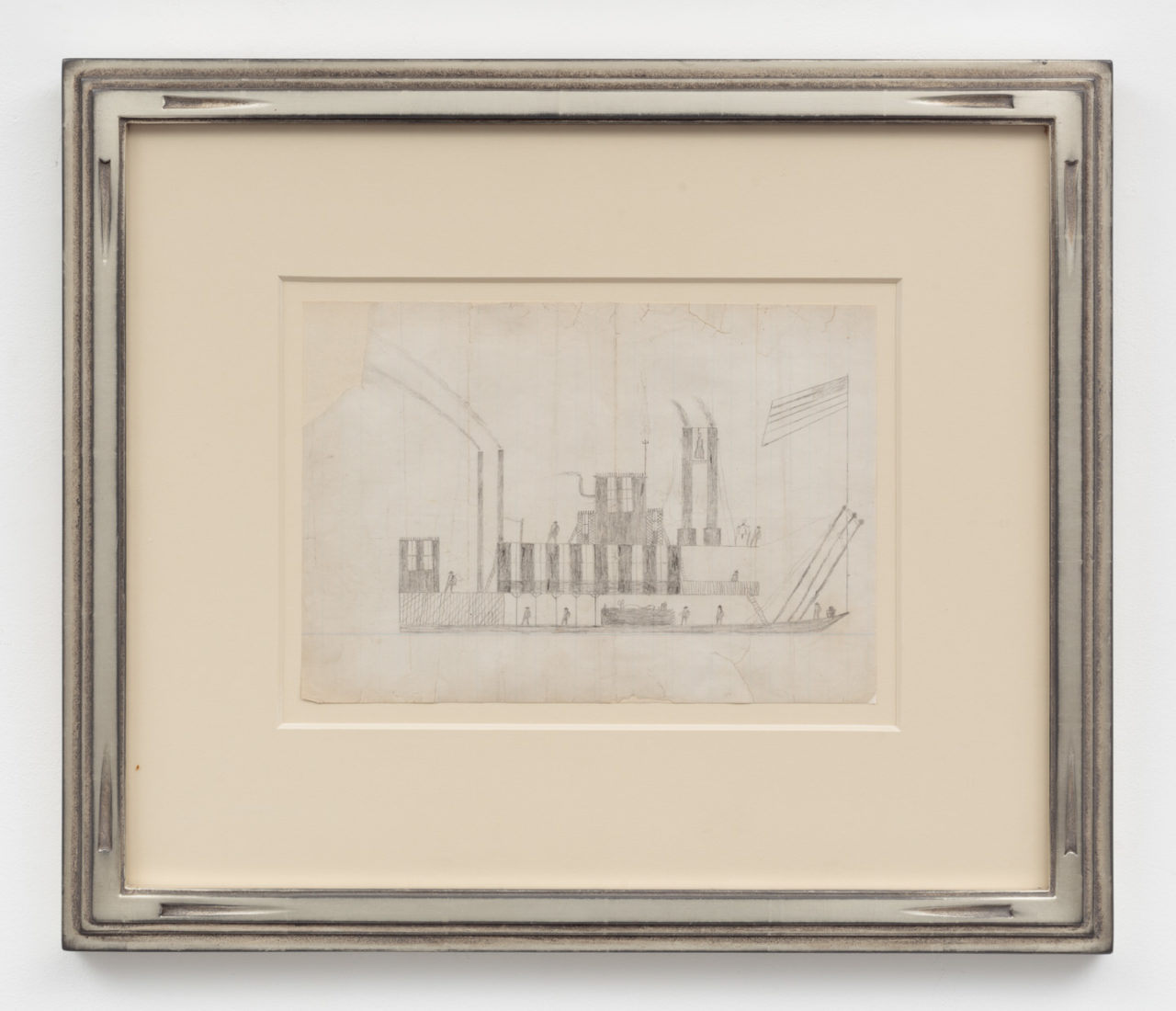
Fort Berthold Artist
Steamboat Sketch
William Courtenay Ledger Book, c. 1870-80
Graphite on paper
7 3/4 x 11 inches -
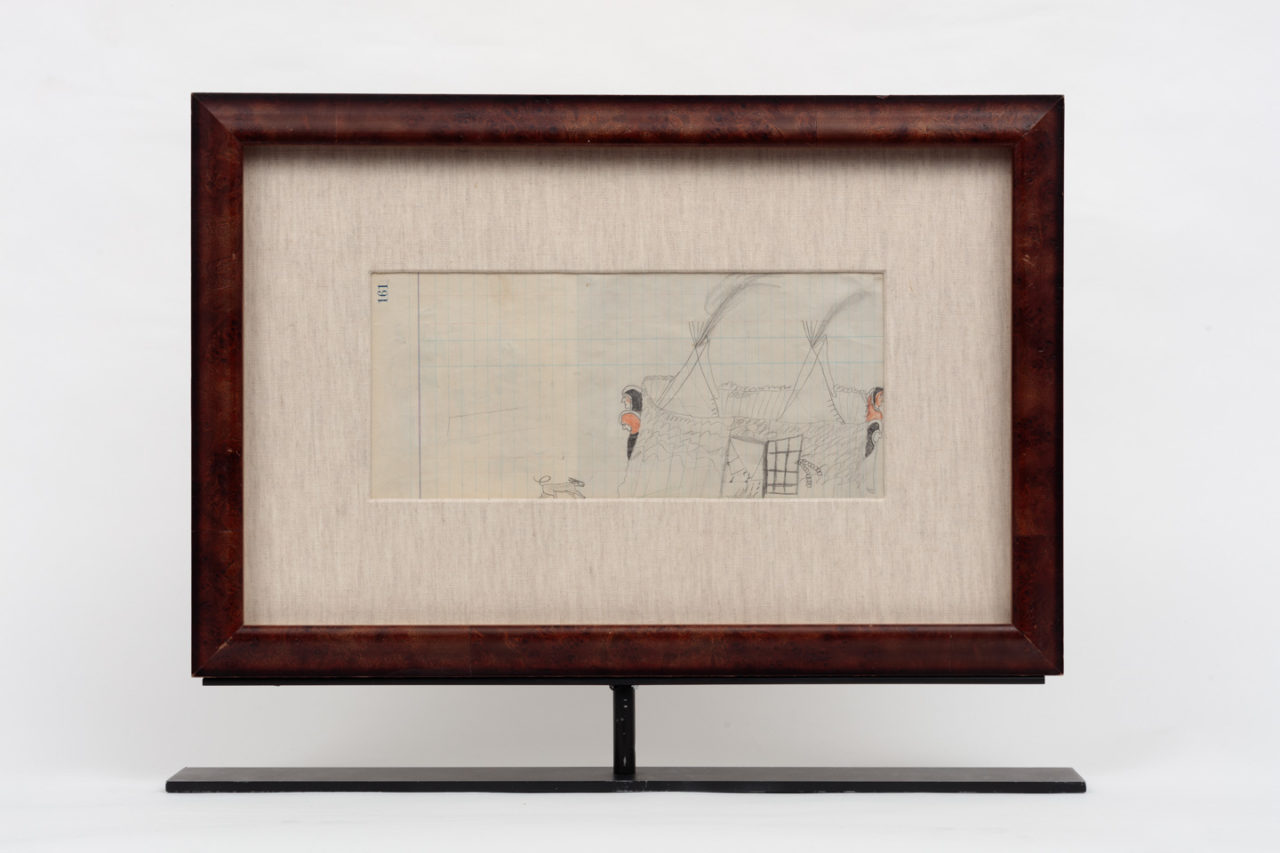
Unknown Arapaho Artist (thought to be an artist found in the Henderson Ledger)
Courting Scene(Side A)
Unknown Ledger Book, p 161-162, c. 1870
Graphite and colored pencil on paper
5 1/4 x 11 3/4 inches -
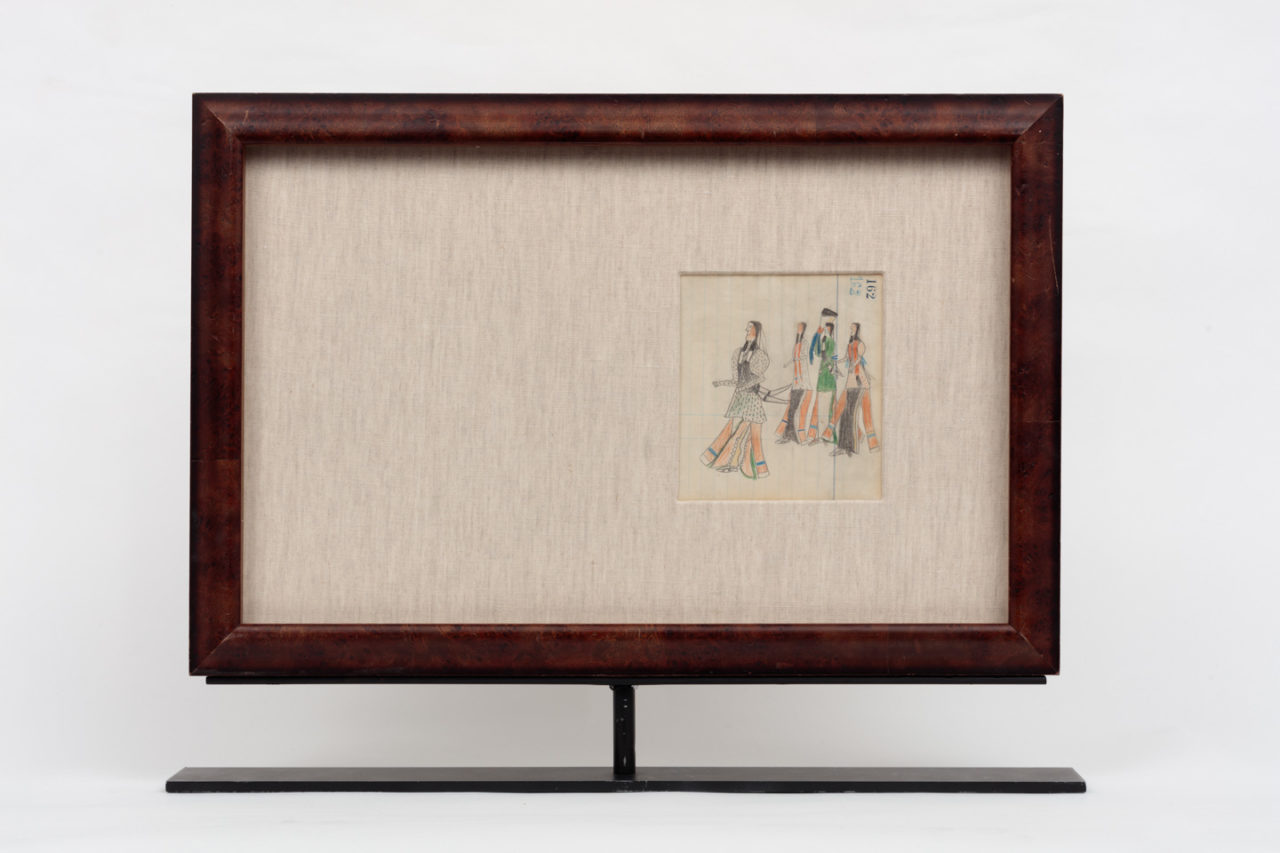
Unknown Arapaho Artist (thought to be an artist found in the Henderson Ledger)
Courting Scene(Side B)
Unknown Ledger Book, p 161-162, c. 1870
Graphite and colored pencil on paper
5 1/4 x 11 3/4 inches -
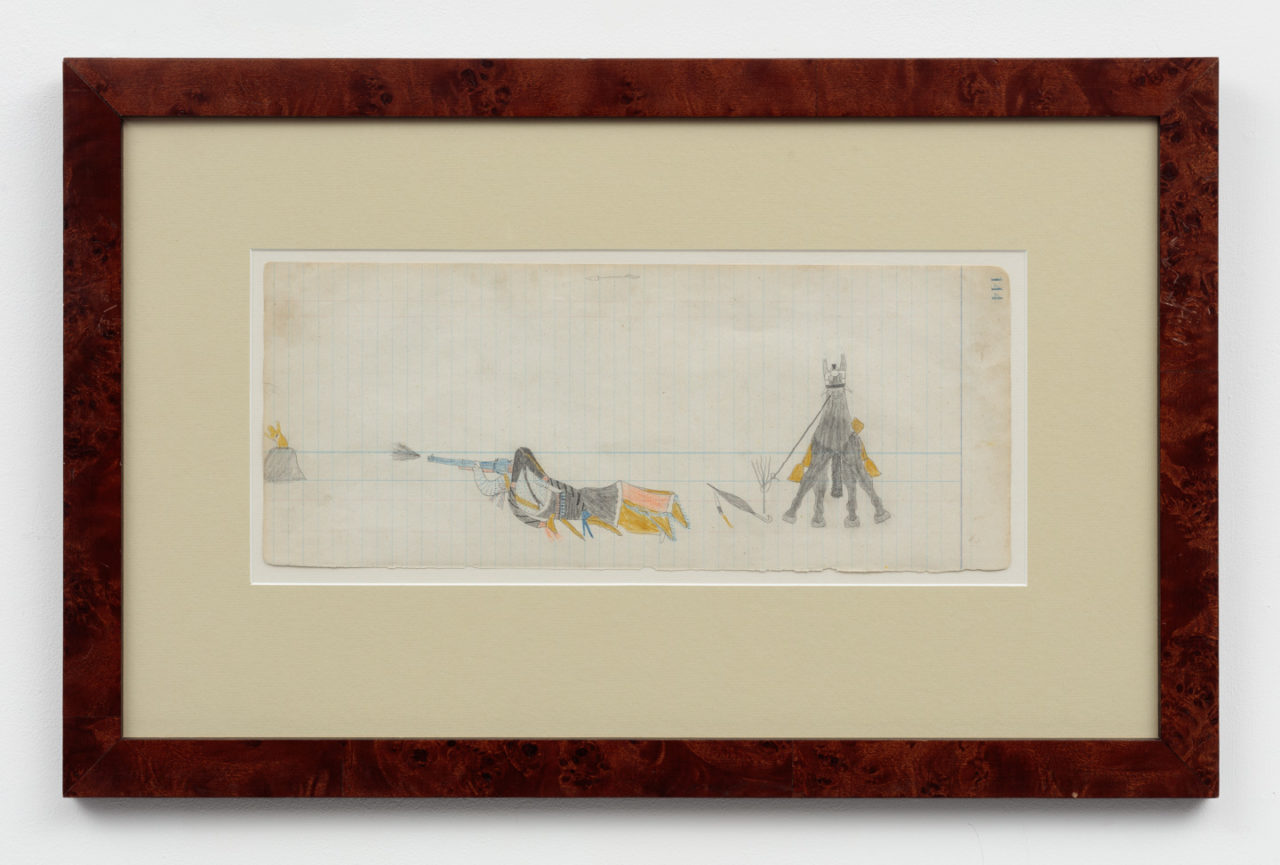
Arrow or Moxos, also known as Flint (Southern Cheyenne, birth date unknown)
Arrow dismounted and taking pot-shots at a prairie dog
Arrow’s Elk Society Ledger Book, p.144, c. 1875
Graphite and colored pencil on paper
6 x 14 3/4 inches -
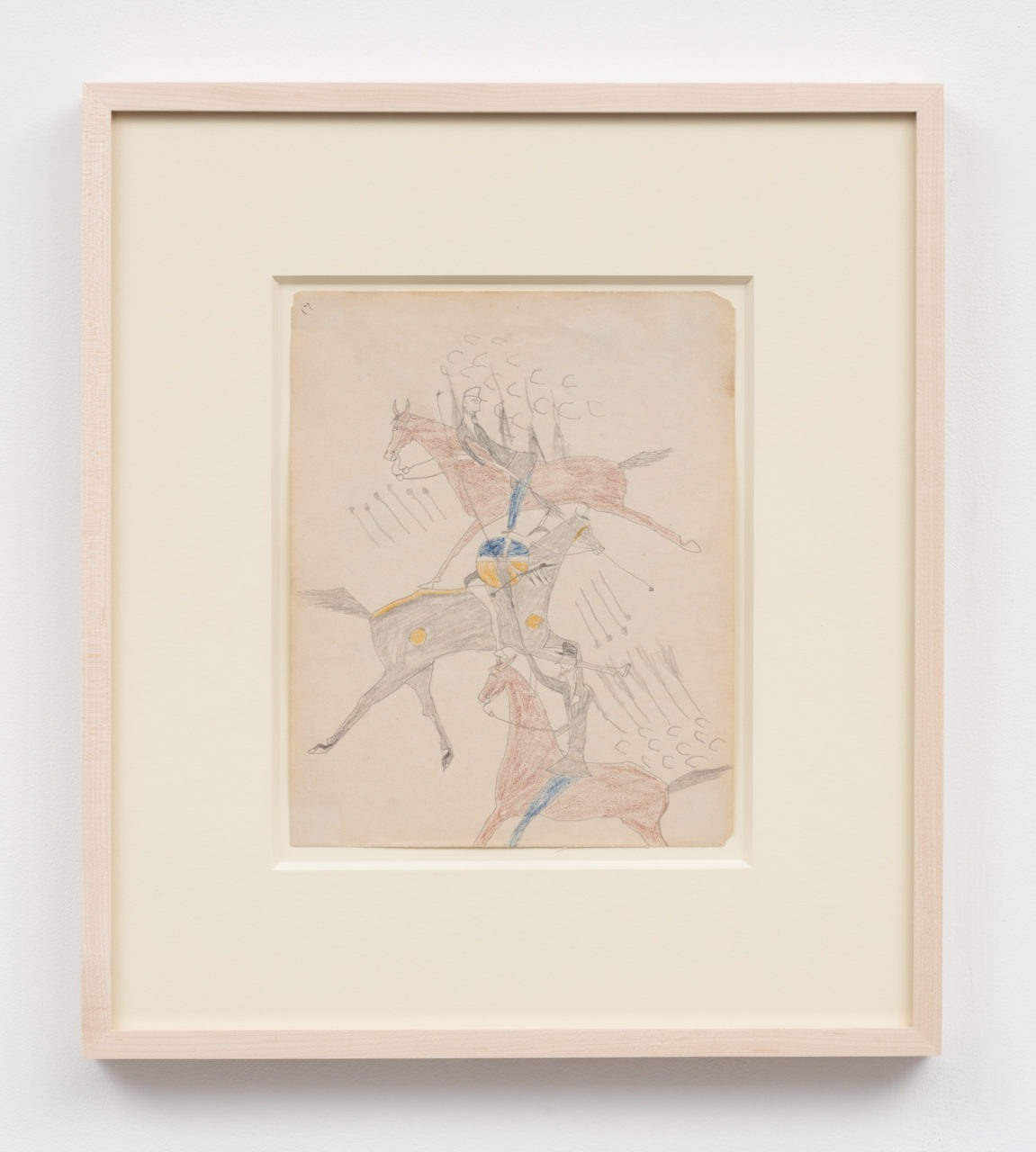
Sitting Bull (Oglala Lakota, b. unknown-1876)
Sitting Bull shooting arrows and carrying his 3 bladed knife as soldiers fire their rifles at him
Saville Ledger Book, p.17, c. 1870
Graphite and colored pencil on paper
9 1/2 x 7 1/2 inches -
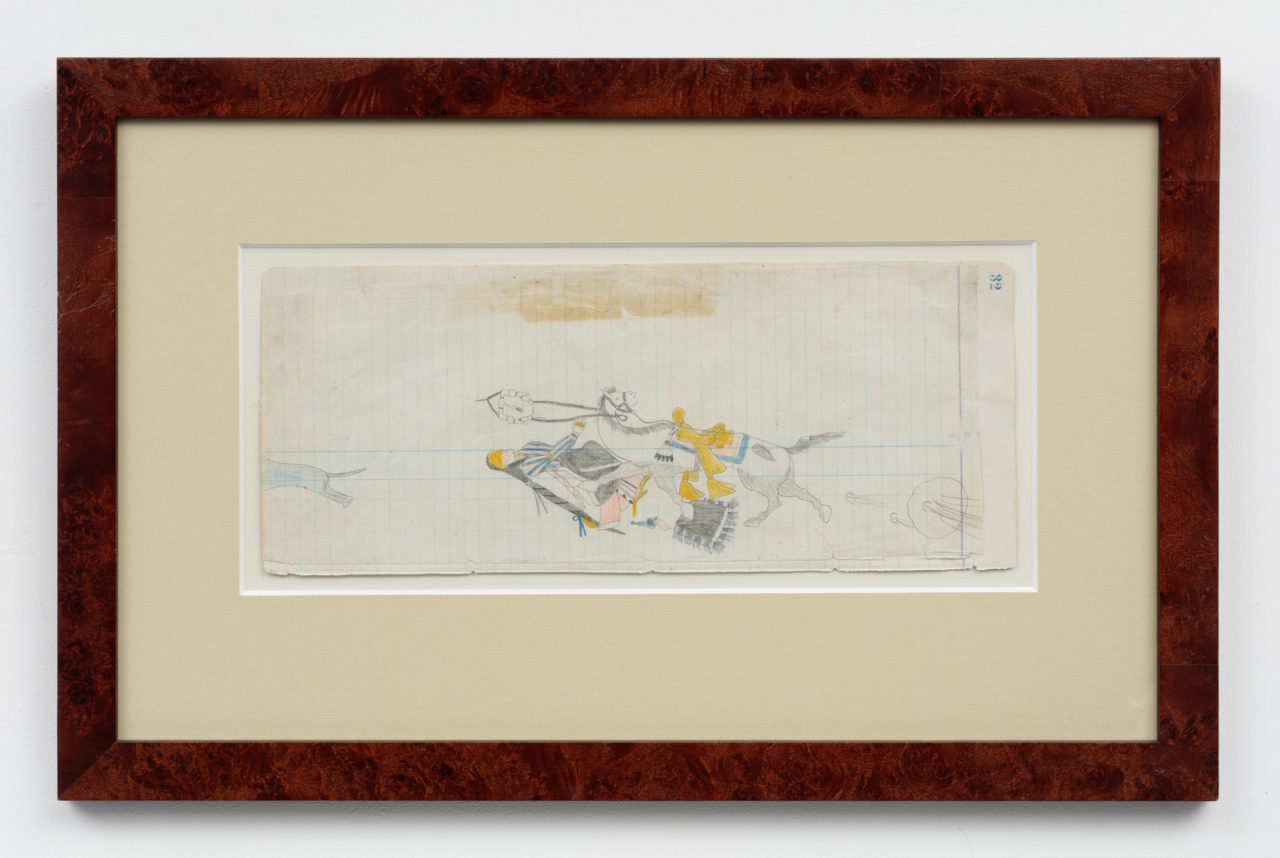
Arrow or Moxos, also known as Flint (Southern Cheyenne, birth date unknown)
Arrow having a riding accident while hunting a domestic dog
Arrow’s Elk Society Ledger, p.32, c. 1875
Graphite and colored pencil on paper
6 x 14 3/4 inches -
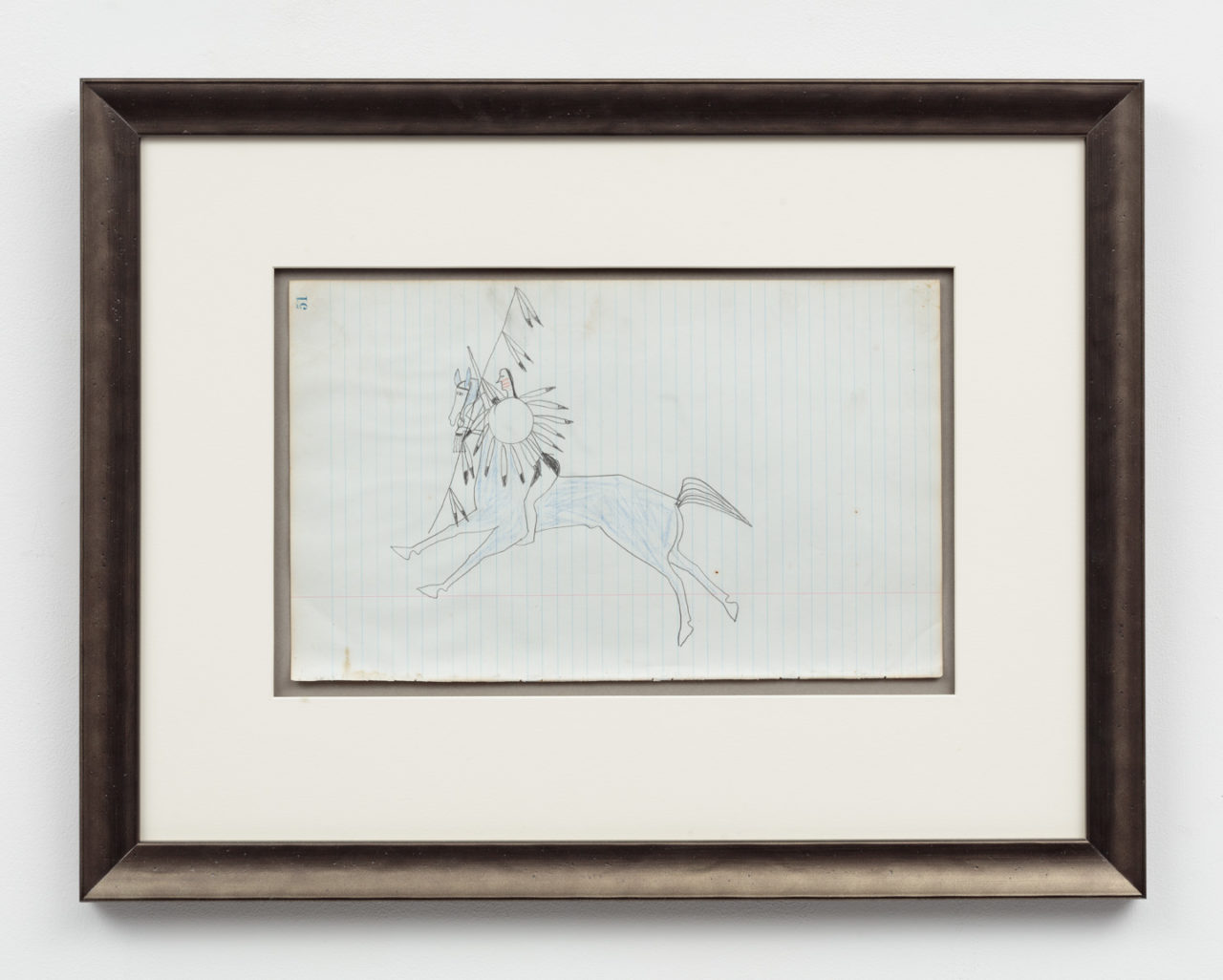
Ćehu´pa/Jaw, or Okicize Tawa, (Hunkpapa Lakota, b.1850)
Lance and Shield Bearer on Blue Horse
Amidon Ledger Book, p.51, c. 1880
Graphite and colored pencil on paper
8 1/4 x 13 1/2 inches -
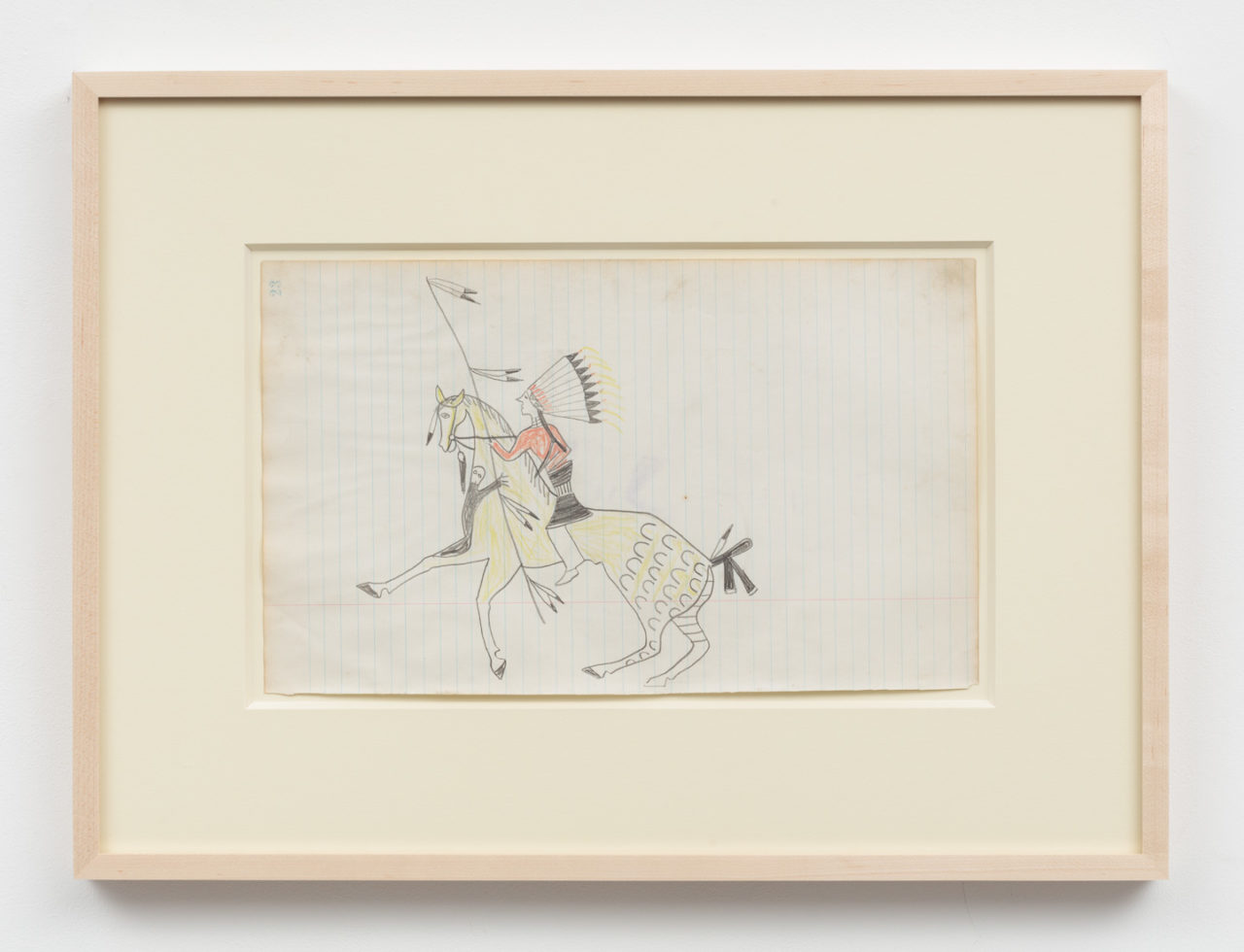
Ćehu´pa/Jaw, or Okicize Tawa, (Hunkpapa Lakota, b.1850)
Amidon Ledger Book, p.23, c. 1880
Graphite and colored pencil on paper
8 1/4 x 13 1/2 inches -
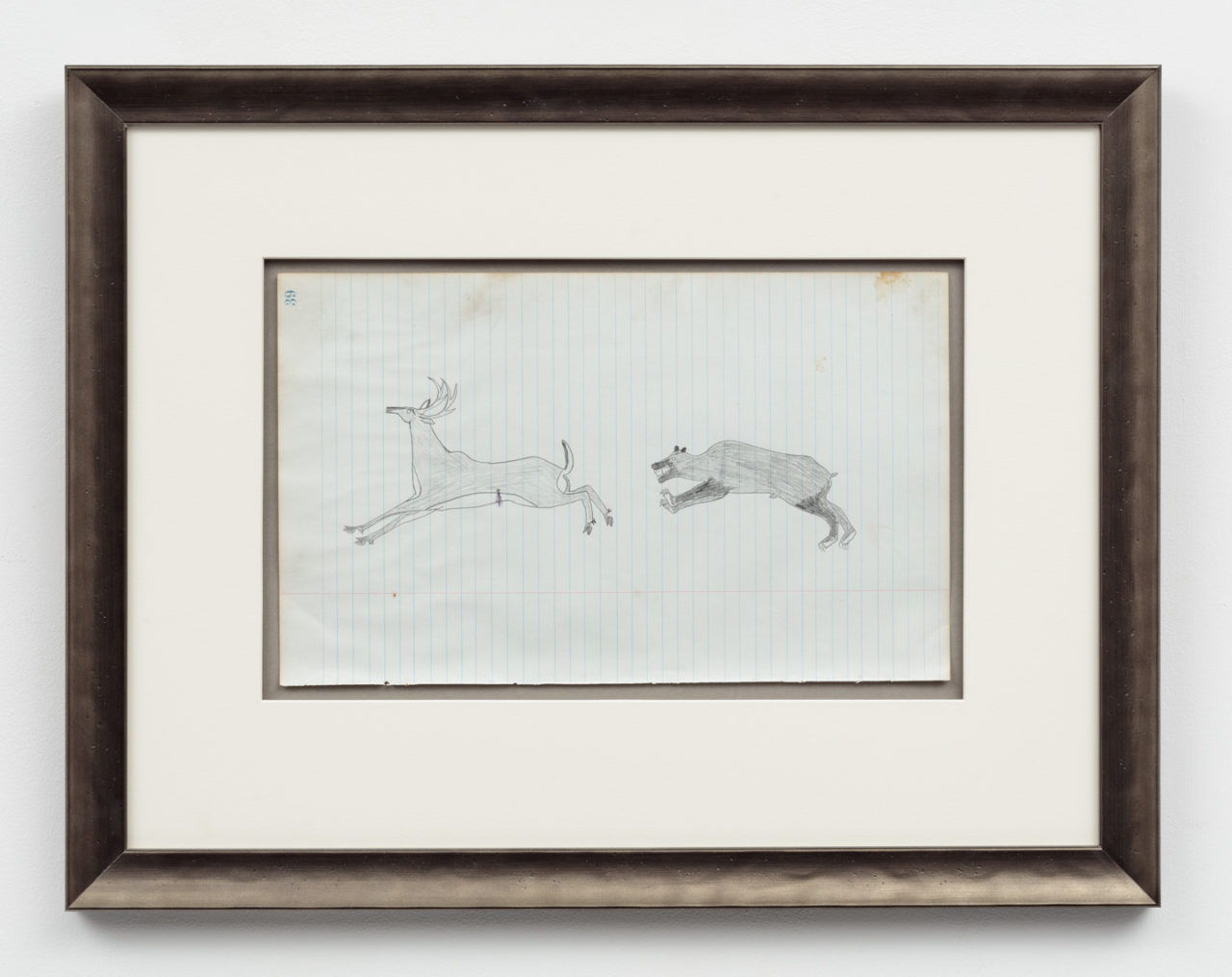
Ćehu´pa/Jaw, or Okicize Tawa, (Hunkpapa Lakota, b.1850)
Bear Chasing a Deer
Amidon Ledger Book, p.39, c. 1880
Graphite and colored pencil on paper
8 1/4 x 13 1/2 inches -
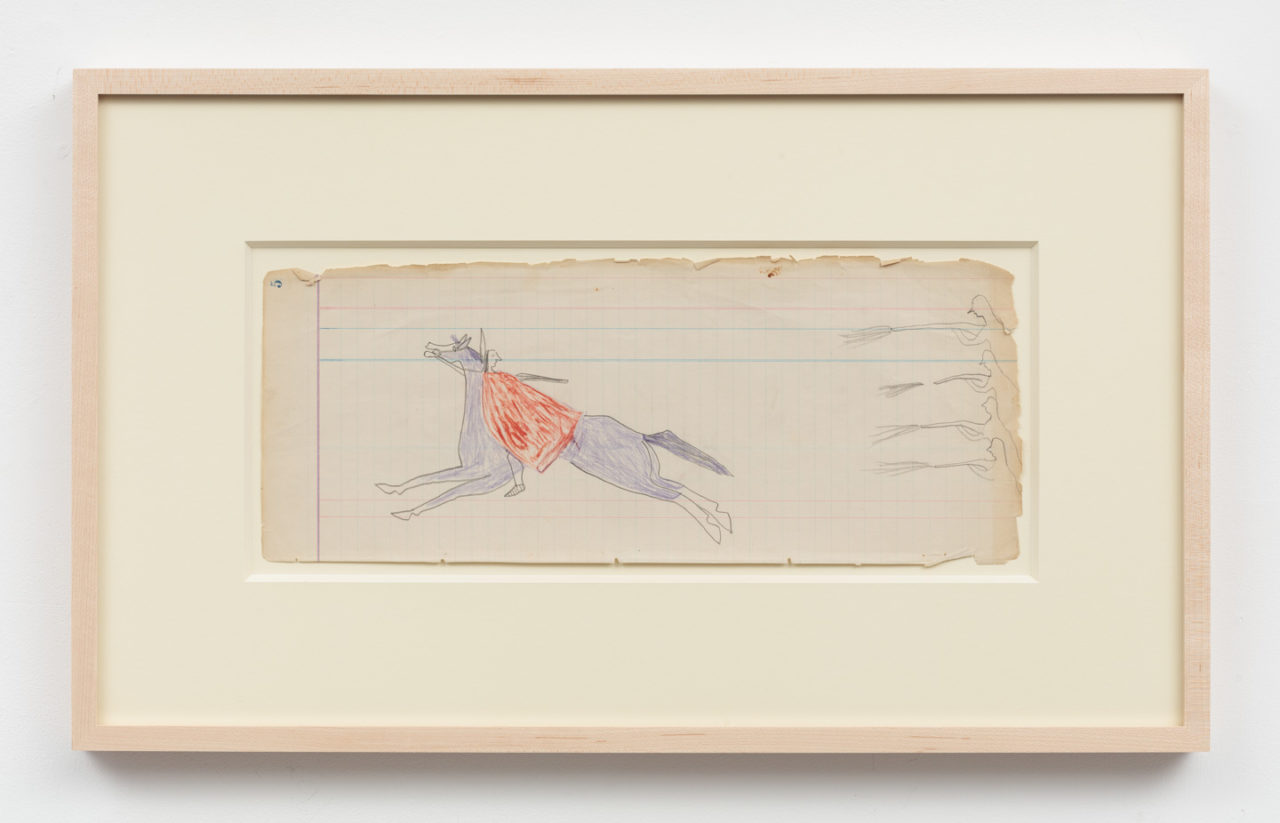
Ćehu´pa/Jaw, or Okicize Tawa, (Hunkpapa Lakota, b.1850)
Macnider Ledger Book, p.5, c. 1880
Graphite and colored pencil on paper
5 3/4 x 14 1/2 inches -
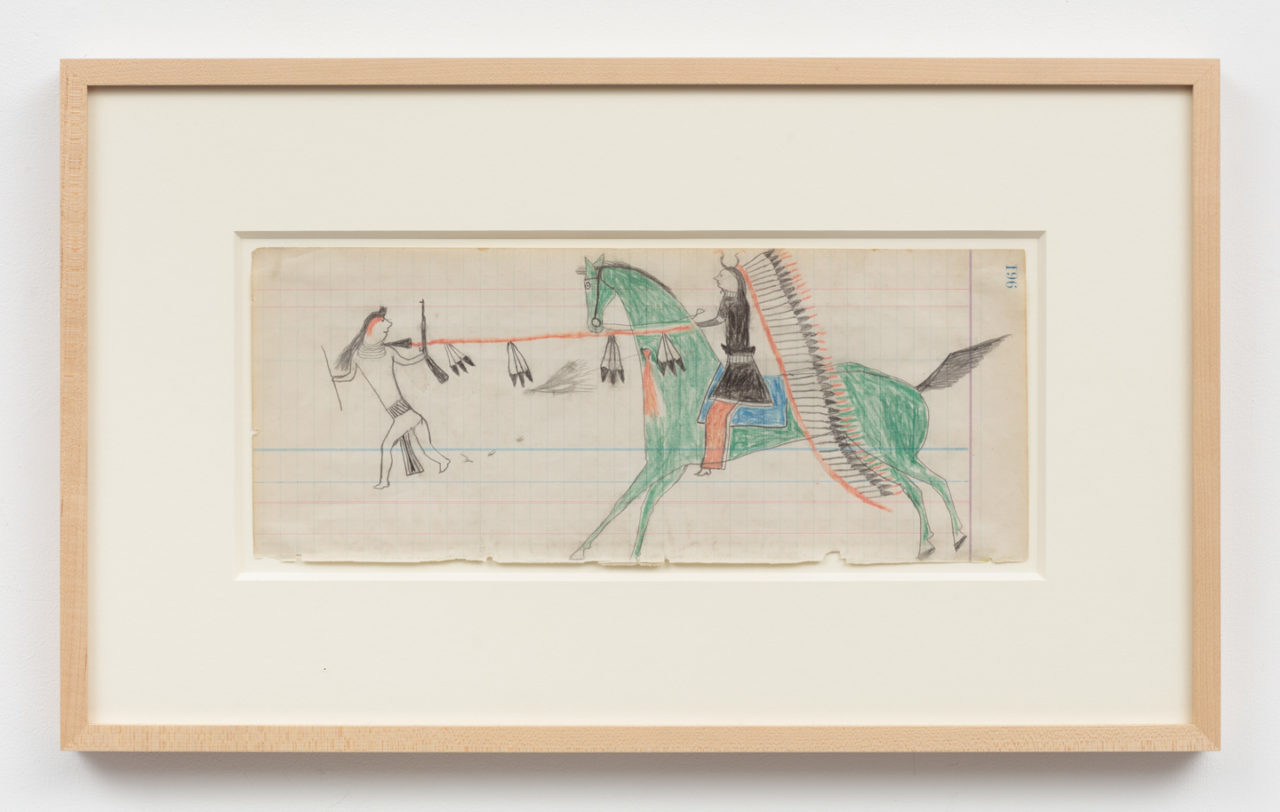
Unknown Artist B
Macnider Ledger Book, p.196, c. 1880
Graphite and colored pencil on paper
5 3/4 x 14 1/2 inches -
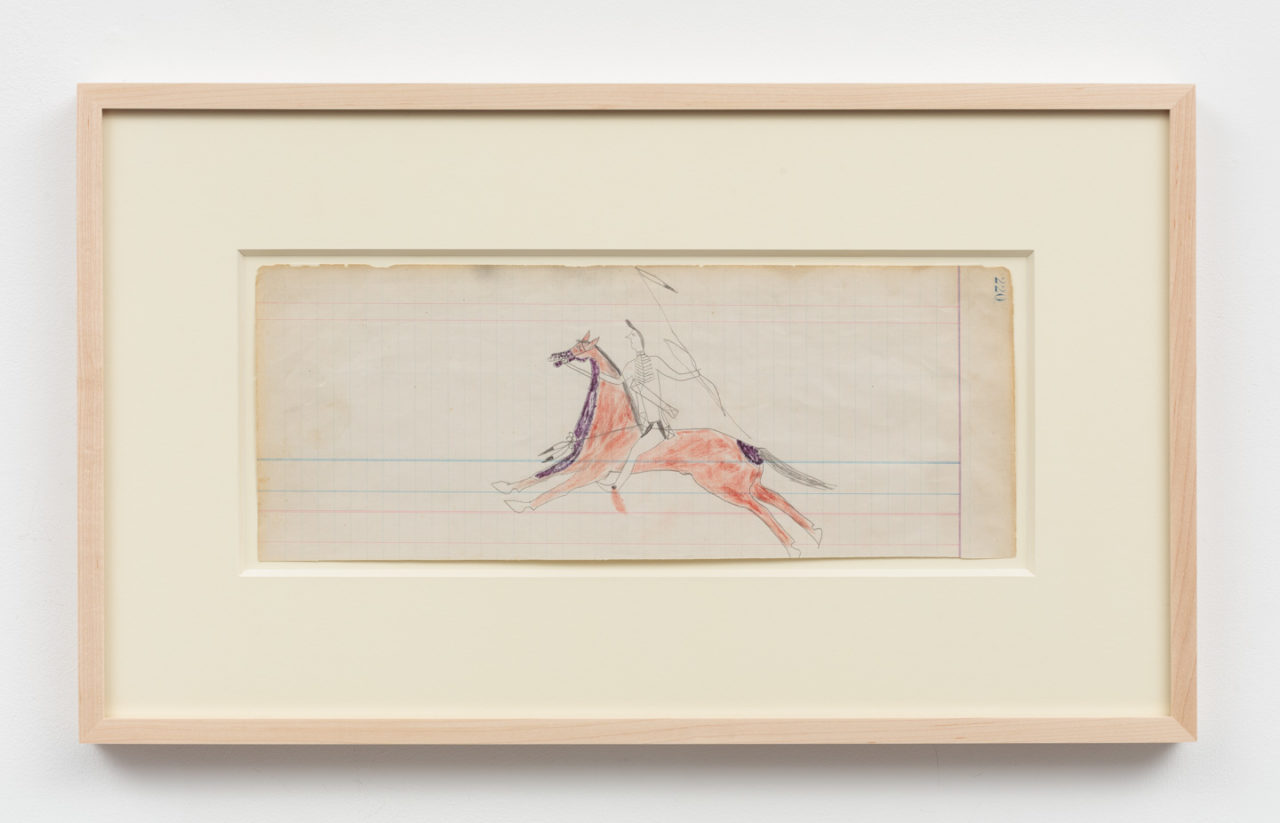
Ćehu´pa/Jaw, or Okicize Tawa, (Hunkpapa Lakota, b.1850)
Macnider Ledger Book, p.220, c. 1880
Graphite and colored pencil on paper
5 3/4 x 14 1/2 inches -
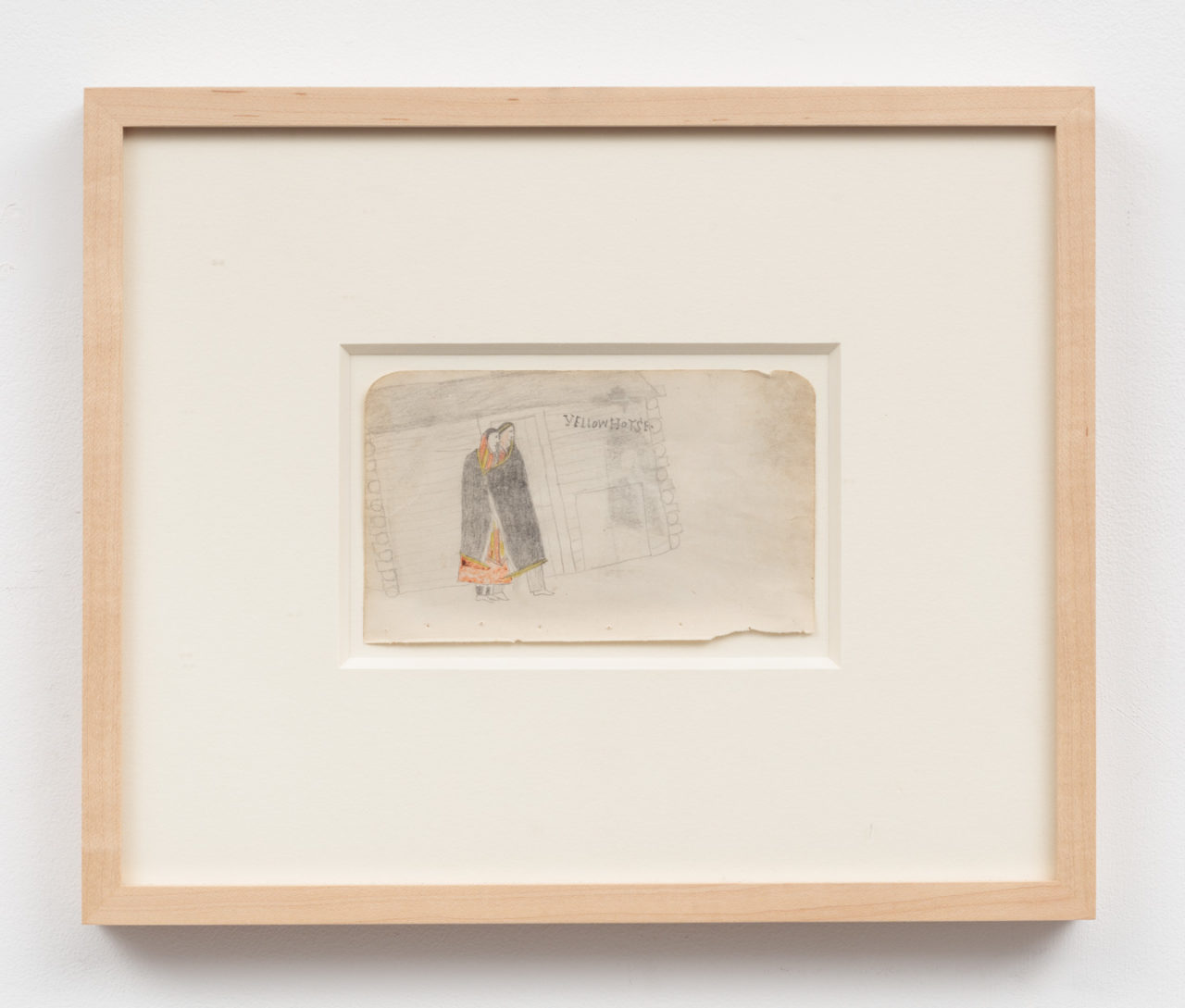
Bear Who Walks on Ridge, or Robert Ridge Walker (Northern Tsistsistas/Cheyenne, 1870-1959)
Ridge Walker Ledger Book, c. 1901
Graphite and colored pencil on paper
3 1/2 x 5 3/4 inches -
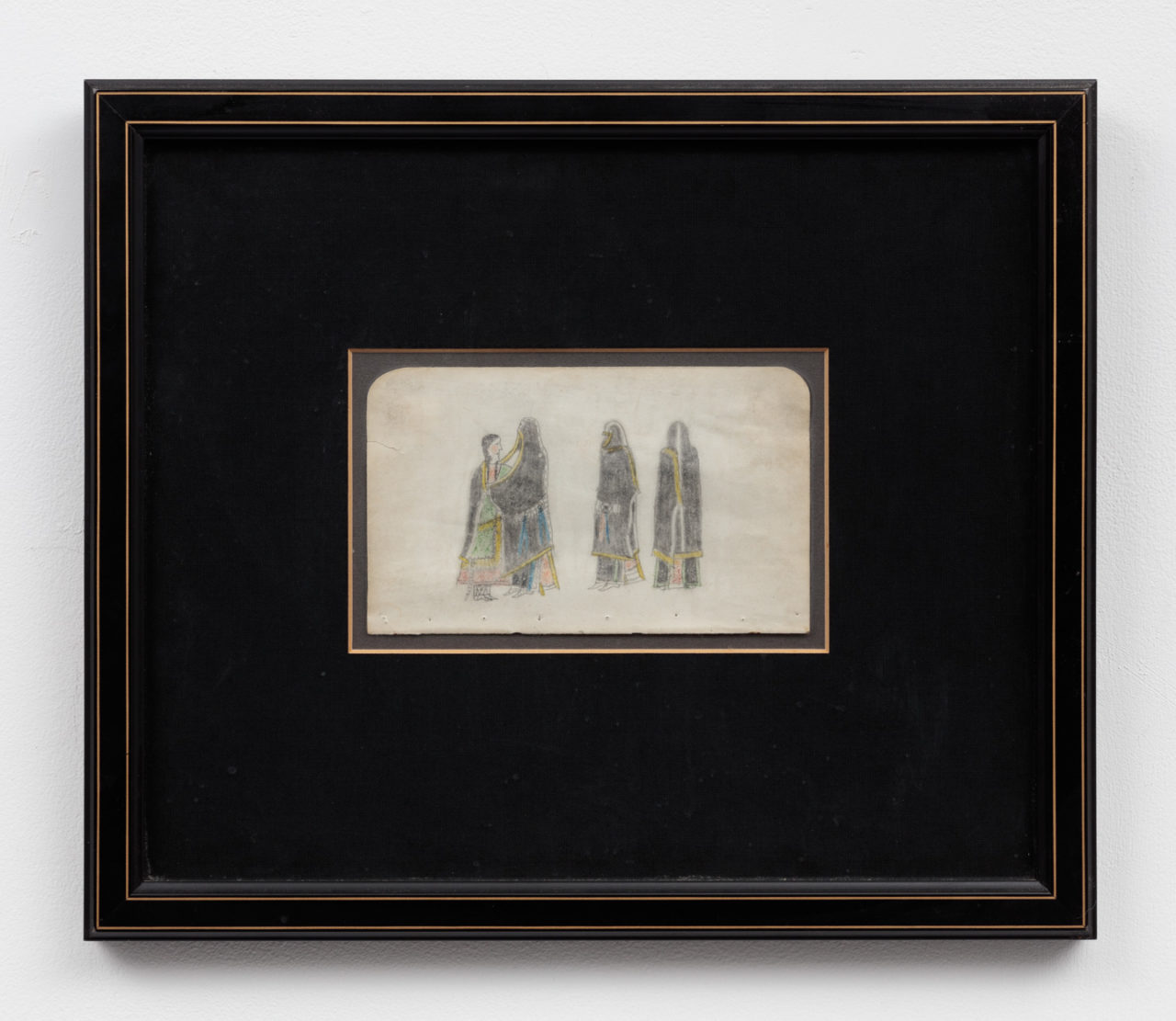
Bear Who Walks on Ridge, or Robert Ridge Walker (Northern Tsistsistas/Cheyenne, 1870-1959)
Courting Scene
Ridge Walker Ledger Book, c. 1901
Graphite and colored pencil on paper
3 1/2 x 5 3/4 inches -
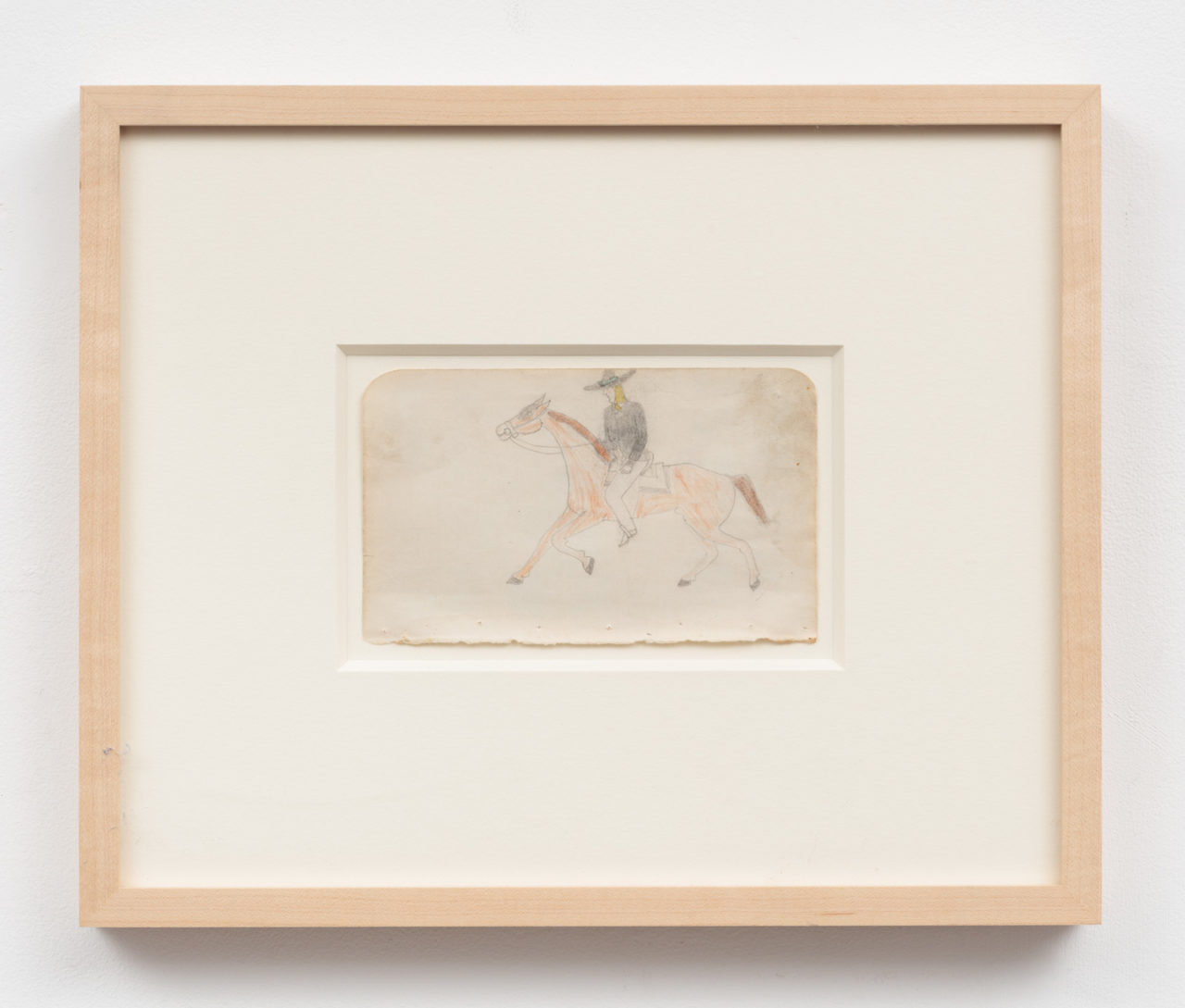
Bear Who Walks on Ridge, or Robert Ridge Walker (Northern Tsistsistas/Cheyenne, 1870-1959)
Ridge Walker Ledger Book, c. 1901
Graphite and colored pencil on paper
3 1/2 x 5 3/4 inches
Press Release
Third Floor
Sometimes Dreams are Wiser than Waking: Plains Ledger Drawings
Organized by Thomas Cleary and Kent Henricksen
Nicelle Beauchene Gallery is pleased to present Sometimes Dreams are Wiser than Waking, an exhibition of late 19th century drawings by Native American artists from across the Plains. Organized by Thomas Cleary and Kent Henricksen, this exhibition brings together several dozen works on paper and one on muslin, all made between 1865 and 1910.
Drawings made by Native Americans from this time period are often generally referred to “ledger drawings.” Created with graphite, colored pencil, and ink on ledger book pages and other paper ephemera, the works depict courting couples, supernatural visions, heroic acts, and scenes of outdoor life. These works marked a shift in media for Native artists, as centuries-old traditions of image making were now being rendered on newly introduced materials. The paper, which is sequentially numbered and lined, was originally intended to record financial transactions by white traders and colonizers in the region. Plains artists repurposed these books as a new means of visual documentation of their cultural traditions and daily life. The ledger drawings provided new avenues for storytelling amidst the violence perpetrated by the United States government during forced relocation and assimilation of Native Americans across the continent.
Featured Artists:
Ćehu′pa/Jaw, or Okicize Tawa, (Hunkpapa Lakota, b.1850)
Amidon Ledger Book and Macnider Ledger Book (both Sioux, c.1880)
The Amidon Ledger Book was principally drawn by a Sioux artist named Jaw (Ćehu′pa), also known as His Fight or Okicize Tawa. Born around 1850, Jaw quickly gained recognition in his youth for being an exceptional horse thief. (That horses were a form of currency on the Plains meant that he was also wealthy at a young age.) Overtime, he also became a distinguished warrior, going on to become a veteran Battle of Little Big Horn in 1876. His military prowess not only gained him celebrity among the Sioux, but also among Anglo-artists and ethnographers. In 1884, American artist De Cost Smith was compelled to paint him due to his accolades. The warrior-artist is best known to us today because around 1912, ethnographer Frances Densmore (1867-1957) interviewed Jaw and was the recipient of several of Jaw’s works. A highly prolific artist, Jaw is known to have drawn several ledger books, one of which is currently housed in the collections at the South Dakota State Historical Society in Pierre, South Dakota.
Approximately one hundred-and-fifty of the Amidon Ledger Book drawings, while unsigned, are largely attributable to Jaw. The book was privately purchased when it was discovered in 1985, underneath a stack of used dictionaries in a used book sale in Amidon, ND. The book was subsequently purchased by H. Malcolm Grimmer of Santa Fe, NM, in 2016 when it was documented by the University of California, San Diego’s Plains Indian Ledger Art project.
Arrow or Moxos also known as Flint, (Southern Cheyenne, b. unknown)
Arrow’s Elk Society Ledger Book (Southern Cheyenne, c.1875)
The Arrow Elk Society Ledger, often abbreviated to be commonly referred to as the “Arrow Ledger,” was drawn by an unknown Southern Cheyenne artist identified as “Arrow” and originally collected in 1882. The book recounts events which took place within his Elk Society, an elite warrior group which included the warrior Vóhko'xénéhe also know as Roman Nose (1856-1917), around the mid-1870s or possibly earlier. Not much else is known about the artist, however, outside of this work. That he is identified as “Arrow” derives from the acknowledgement that the protagonist of the several drawings is identified by an arrow glyph (which hovers above him). He is listed on a census of the Southern Cheyenne in Band 57 of the year 1884 as “Flint”. It is worth noting that an arrow is a sacred symbol amongst the Cheyenne, indicating that the artist was distinguished among his peers and perhaps held significant office within various religious groups.
The Arrow Elk Society Ledger book was initially purchased in 1882 at the Darlington Agency in “Indian Territory,” Oklahoma. The seventy-two drawings were later sold as an entire lot at Sotheby’s, New York in June, 1997; researched by Plains scholar Mike Cowdrey from 1997 to 1999; and subsequently presented and individually sold by Morning Star Gallery of Santa Fe, NM in 1999. The drawings can today be found in several important institutional collections, including the collection at the Hood Museum at Dartmouth College in Dartmouth, MA.
Frank Henderson (Hinono'eiteen/Arapaho, 1862–1885)
Frank Henderson Ledger Book (Southern Arapaho, c.1882)
Frank Henderson (1862-1885) is a celebrated Arapaho artist who, at twenty years of age, was the principal artist in what is today considered a tour-de-force work. Known today as the Frank Henderson Ledger Book, the book was originally gifted in December 1882 to Martha Underwood, a former teacher of Henderson’s while he attended the Carlisle Indian School in Carlisle, PA. The book debuted at Acevedo Gallery in New York, NY, in 1988, where it was extensively researched and the individual pages were subsequently sold. Today, select pages from the book can be found in the collections at the Hood Museum at Dartmouth College, Dartmouth, MA and the Metropolitan Museum in New York, NY. This book is particularly celebrated not only for its superior draftsmanship and intricate use of color, but also because Arapaho ledgers are exceedingly rare.
But for a signed and dated inscription on the inside cover of the book, Henderson’s true identity and Arapaho name remain unknown. “Frank Henderson” was a name assigned to the artist during his enrollment at the Carlisle Indian School. In spite of this, current research suggests that the book itself was likely authored by several different artists – some of whom might have possibly been affiliated with a Cheyenne tribe. This book was created not long before Henderson’s untimely death. Therefore, while Henderson was not a particularly prolific artist, his contribution to the corpus of extant Arapaho ledger work is significant.
Old White Woman (Southern Cheyenne, b. unknown)
Old White Woman Ledger Book (Southern Cheyenne, c. 1880-90)
The Old White Woman Ledger originally consisted of forty-six pages which were drawn by a Cheyenne artist named Old White Woman in the late 19th century. The book discovered by Morning Star Gallery, in Santa Fe, NM, prior to 1992, and the pages were subsequently sold individually.
Little is known about the chief artist, although the book demonstrates a more sophisticated drawing style – featuring more complex compositions and themes – which is often indicative of late 19th century ledger drawing. Furthermore, the themes are also more suggestive of a later generation of ledger work, showcasing courting scenes, dances and dress ornamentation. Noteworthy pages from this book can be found in the collections at the Hood Museum at Dartmouth College, Dartmouth, MA and the Fennimore Museum in Cooperstown, NY.
Bear Who Walks on Ridge, or Robert Ridge Walker (Northern Tsistsistas/Cheyenne, 1870-1959)
Ridge Walker Ledger Book (Northern Cheyenne, c. 1901)
The Ridge Walker Ledger Book is named after Northern Cheyenne artist, Robert Ridgewalker (c. 1870-1959). This particular book is presumed to have been executed by him in 1901, not long after his employment as a scout in for the US army.
The book is recognized not only for its smaller format – 3 ½” by 5 ¾”, per page – but also its intimate depiction of reservation life at the turn of the century. This book was drawn a generation after many of the initial books emerged. Consequently, its focus is on courting scenes and reservation life. Noteworthy pages from this book can be found in the collections at the Hood Museum at Dartmouth College, Dartmouth, MA and the Fennimore Museum in Cooperstown, NY.
Sitting Bull (Oglala Lakota, b. unknown - 1876)
Saville Ledger Book (Sioux, c. 1870)
The Saville Ledger Book consists of a portfolio of 29 pages. Images from this ledger were first published in the newspaper- THE DAILY GRAPHIC: NEW YORK, THURSDAY, JULY 13, 1876. Scenes depicted in this book are from the Fetterman Massacre near Fort Phil Kearny, W.T., 21 December 1866, an attack on a Pawnee earth lodge village, the Powder River War and subsequent Red Cloud's War, 1865-1867.
Sitting Bull is known to have been a member of the Wiciska Warrior Society. He is credited for stopping a riot at the Red Cloud Agency and given an engraved rifle by President Grant. Sitting Bull (Oglala) was also part of a large delegation of Oglala and other Sioux who were summoned to Washington for conferences regarding the proposed